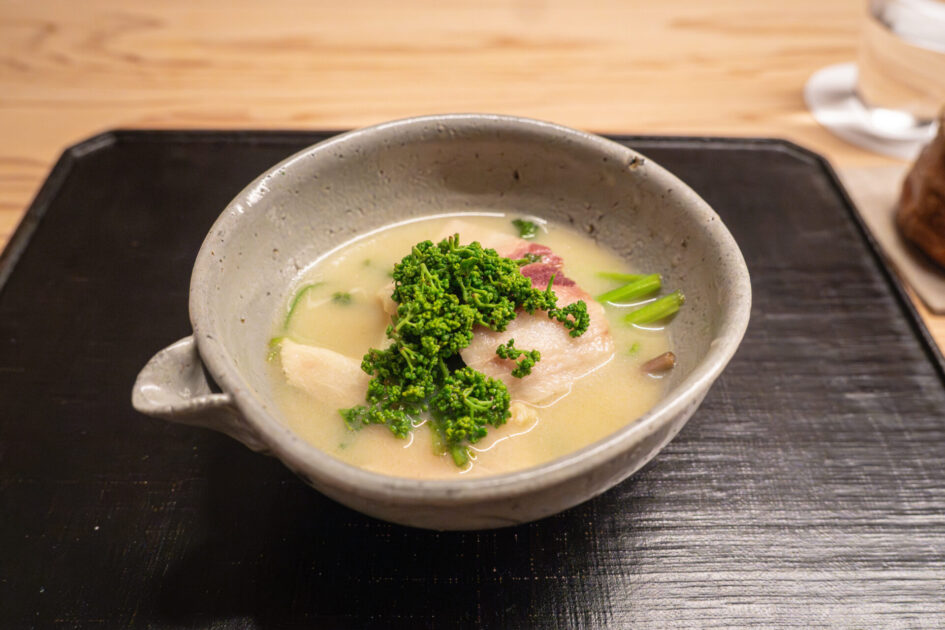CONTENTS
About Oryōri Hirooka
Concept
Just a short walk from Kintetsu Nara Station, Oryōri Hirooka is nestled along a quiet street, offering a calm and refined space where guests can leisurely savor the flavors of the season.
Rooted in precise and thoughtful techniques that bring out the best in each ingredient, the cuisine occasionally incorporates subtle layers of aroma and texture for added depth. While the overall impression is one of gentle elegance, moments of delightful surprise and playful creativity emerge throughout the meal.
I visited without knowing about the restaurant’s previous location, but I was simply glad to discover such a place in the heart of the city—a spot where you can truly enjoy this level of dining.
About Chef Hirooka
Chef Hirooka, the owner of Oryōri Hirooka, hails from Gojō in Nara Prefecture. His journey into the culinary world began with his early exposure to cooking at his family’s izakaya. Guided by his own instincts, he has steadily built up his experience over the years—an accumulation that now breathes naturally through his cuisine.
His approach is unpretentious and never forced, yet each dish is crafted with sincere attention and care. Through this attitude toward his cooking, one can quietly sense the chef’s personality and the path he has walked.
During his time in Gojō, he earned a Michelin star. Now based in the heart of Nara City, he continues to engage wholeheartedly with the art of daily cuisine in a new setting.
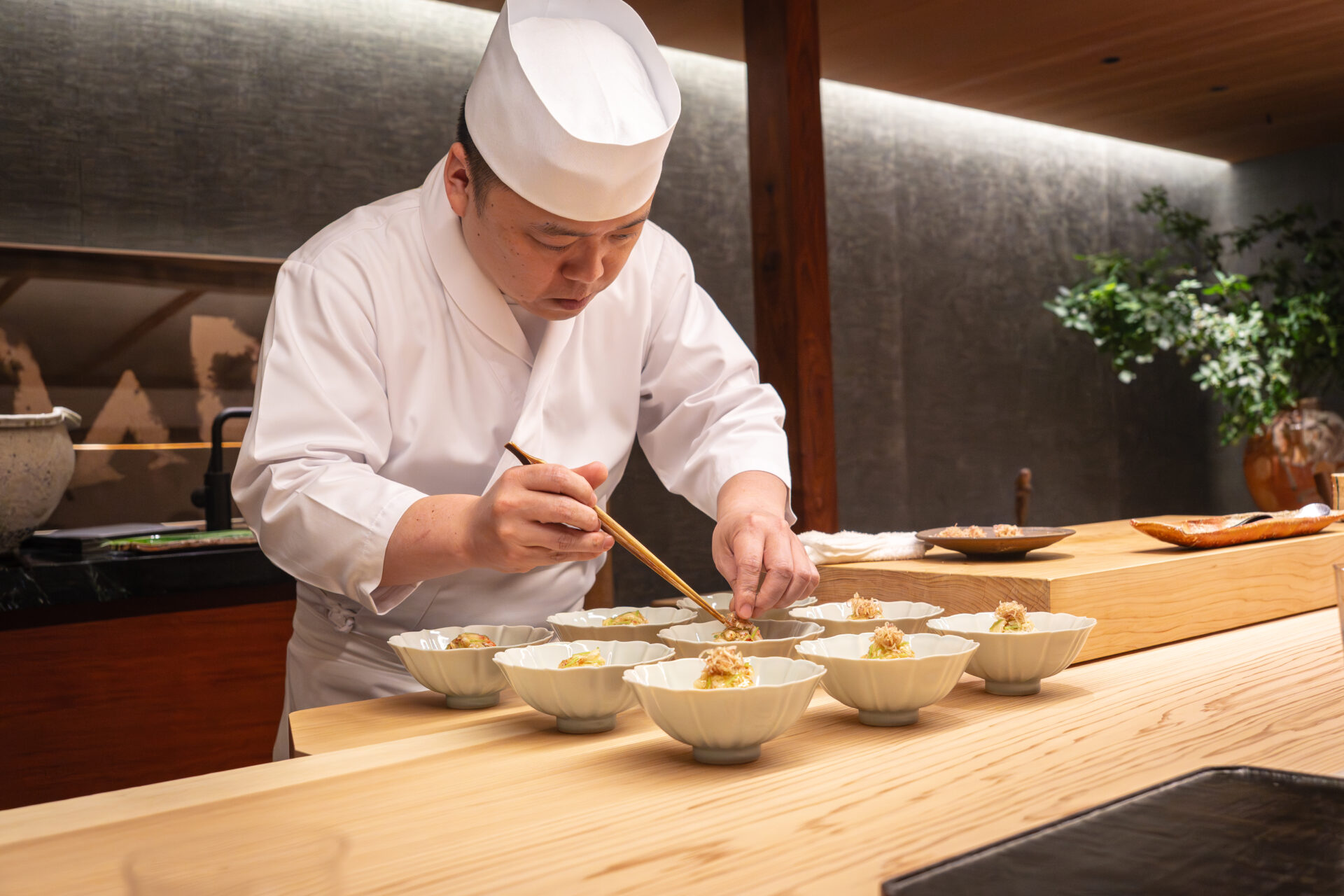
Restaurant Reputation
Oryōri Hirooka has been drawing attention since its earlier days in Gojō, Nara. In the 2022 edition of the Michelin Guide Kansai, it was awarded one Michelin star—a distinction it has maintained even after relocating to its current location near Nara Station.
Rather than relying on flashy or showy presentations, the restaurant earns its acclaim through the consistency and care evident in every dish. Many reviews highlight the calm dining atmosphere and the unwavering quality of the cuisine. It’s a place that not only impresses tourists, but also enjoys strong support from local patrons.
With a low-key presence and a solid reputation built on trust and skill, Hirooka is a hidden gem known and cherished by those in the know.

Dining Prelude
Exterior & Entrance
Just a short walk from Kintetsu Nara Station, Oryōri Hirooka sits modestly along a street lined with commercial buildings and hotels. Its sign is understated—so much so that you might pass it by if you’re not looking closely. Yet, this subtlety perfectly captures the essence of the restaurant.
Opening the door, the noise of the city fades away into a hush. The entrance, accented with natural wood textures and small, thoughtful touches, reflects the chef’s refined aesthetic. The space is calm and unembellished, creating a soothing atmosphere that gently grounds you.
It isn’t a space that feels “special” in an extravagant way—but rather one that feels complete in its simplicity. Even first-time visitors will find themselves stepping in with ease and settling into a relaxed state of mind.
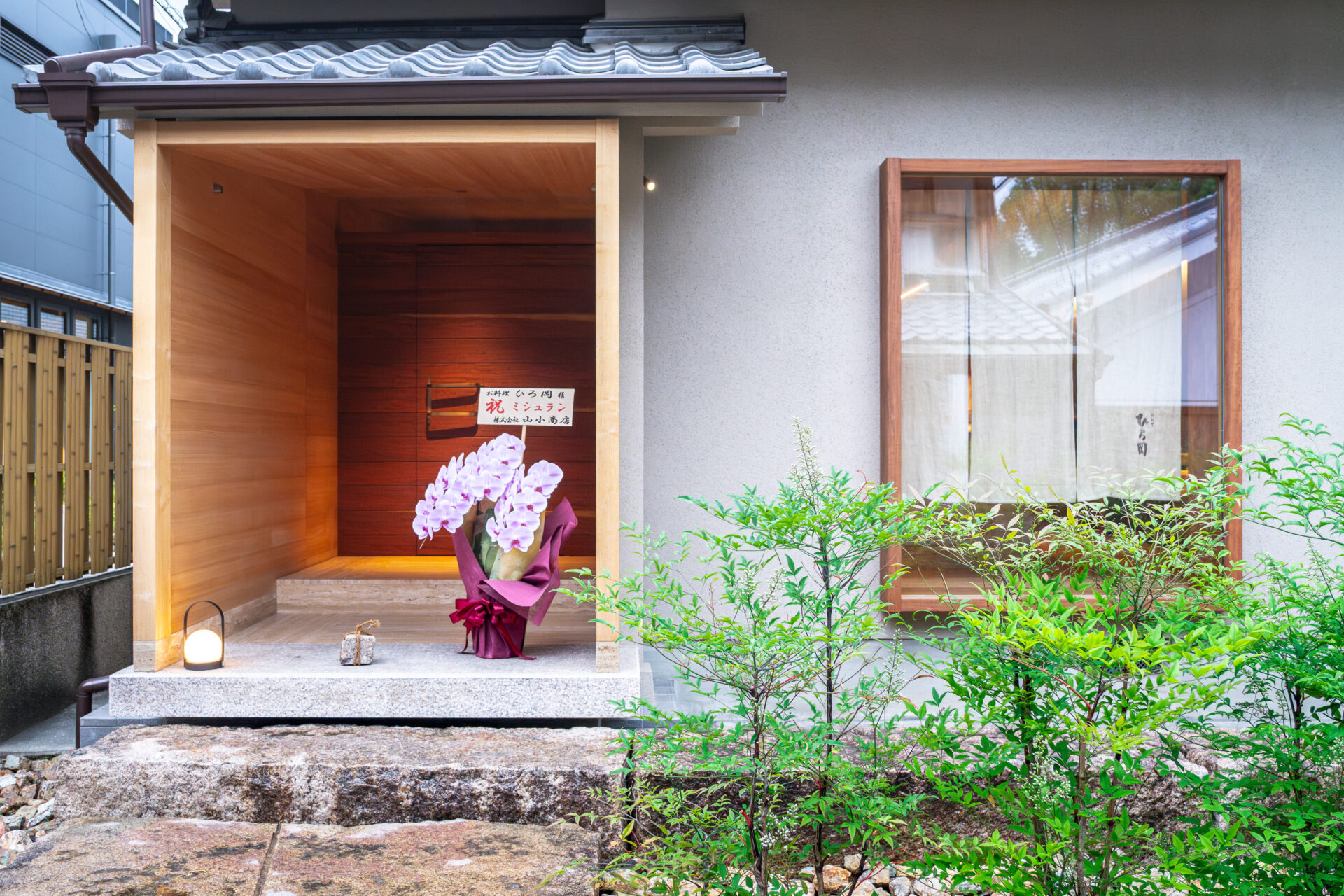
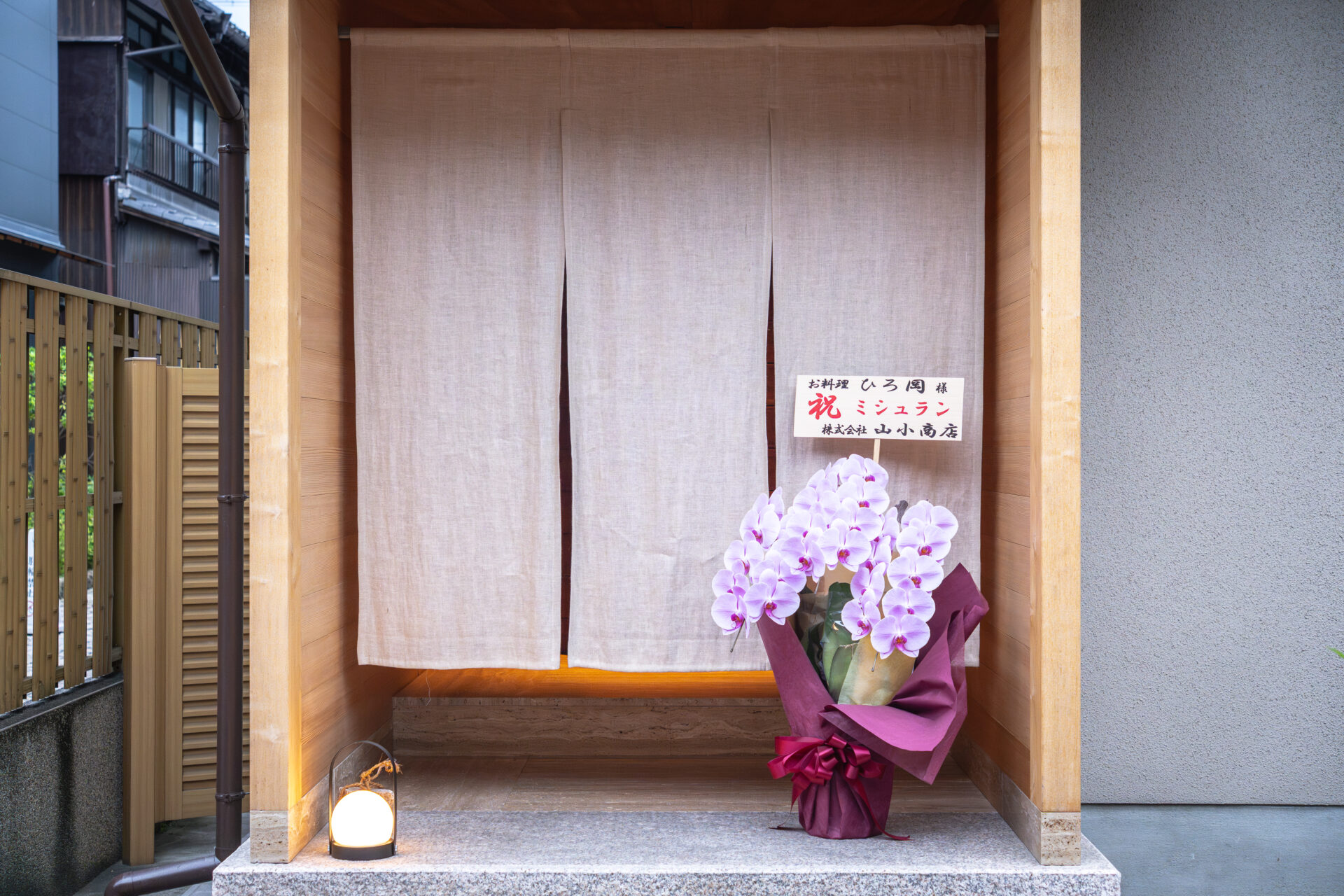
Dining Space
The interior of Oryōri Hirooka is composed with serene simplicity, free from excess. The natural warmth of wood and the soft glow of indirect lighting create a peaceful ambiance, while every detail—from the floral arrangement in the alcove to the carefully chosen décor—quietly reflects the chef’s refined aesthetic.
One distinctive feature is the counter seating, arranged so that guests sit right beside the chef. There is no physical barrier between the kitchen and the diners, allowing you to observe every movement, every breath of the culinary process up close. Chef Hirooka himself joked, “This might be the restaurant with the closest distance between guests and the chef in all of Japan.”
This natural intimacy sets a relaxed tone, softening the atmosphere and enriching each exchange, whether spoken or silent.
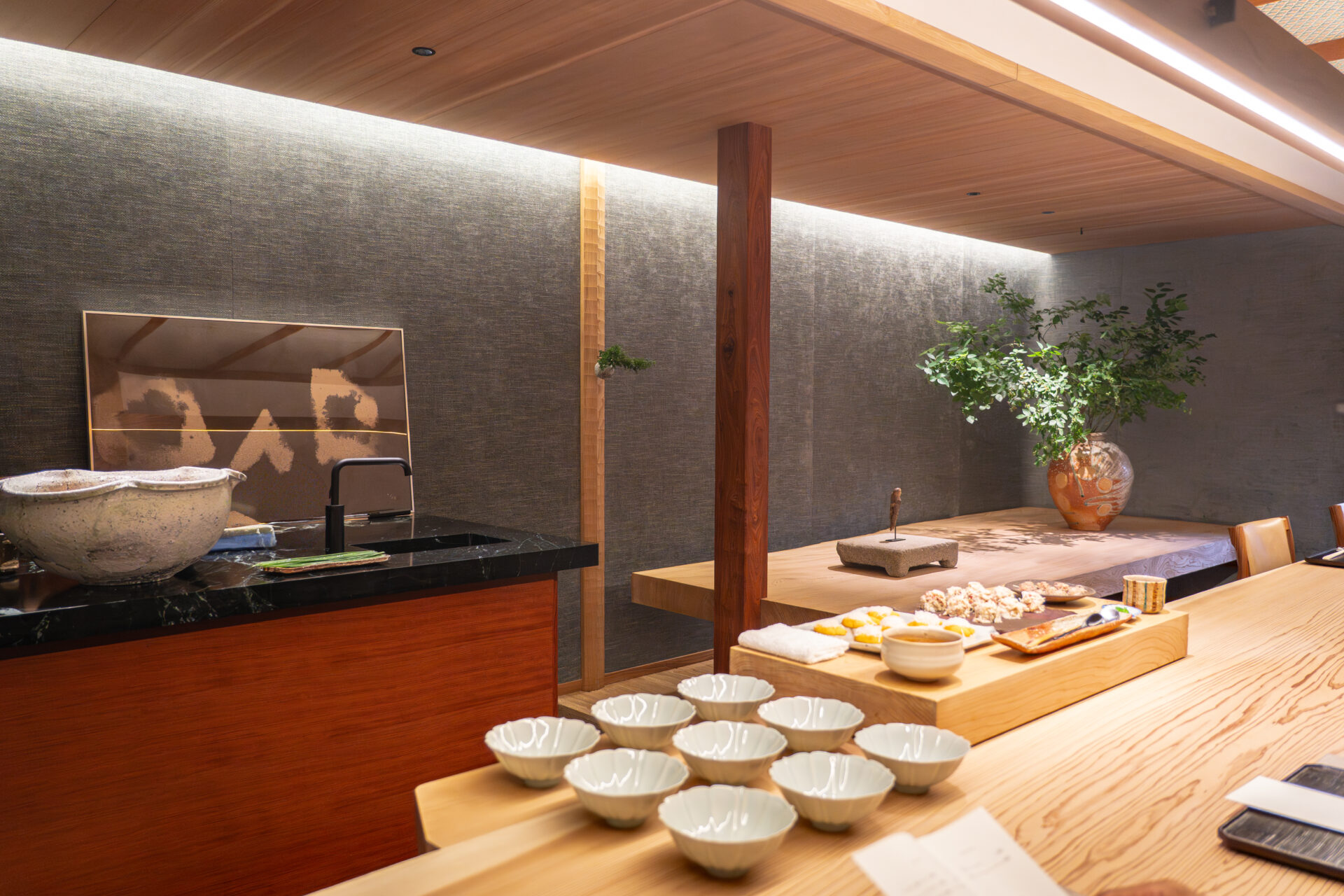
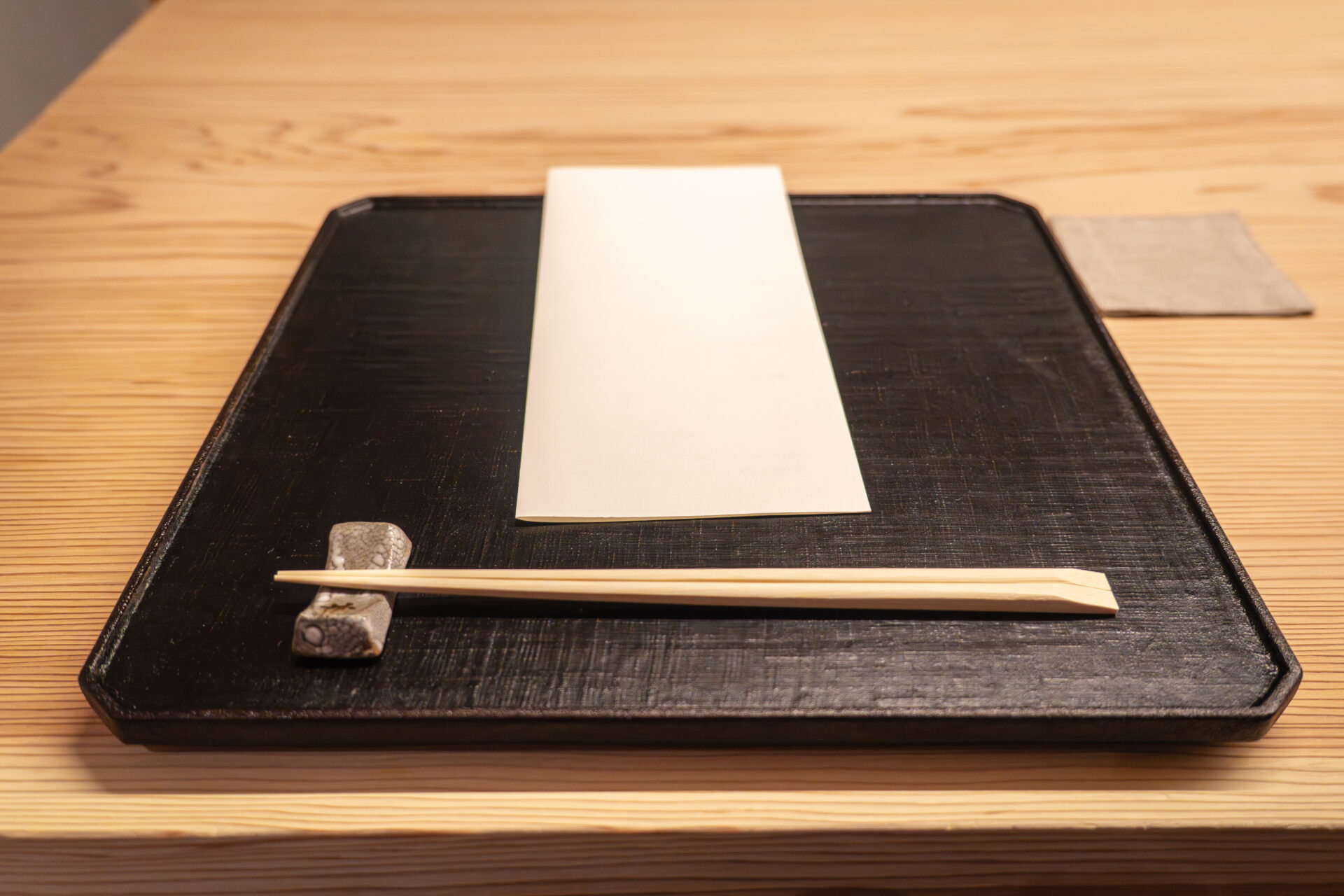
Menu Presentation
Once seated, you’ll notice there’s no menu, nor any formal introduction. The experience begins with quiet subtlety, and it quickly becomes clear that the meal will unfold as an omakase—entrusting the chef to guide the course.
A seasonal tasting menu begins to take shape, delivered from the chef’s hands with calm precision and care. The progression flows naturally, inviting you to surrender to it—not through explanation, but through trust.
Without rigid expectations or excessive explanation, yet with unmistakable clarity in its flow, the meal’s quiet opening reveals the chef’s thoughtful, measured approach to his craft.
Starter Drink
The meal begins with a drink. While the chef’s recommended sake was certainly tempting, I chose to start the evening with a small bottle of Sapporo Black Label.
Served at the perfect temperature—not too cold, just right—the first sip of the beer brought a gentle sense of ease. Whatever tension had lingered melted away, preparing both body and mind for the meal ahead.
It was a quiet, centering way to begin.
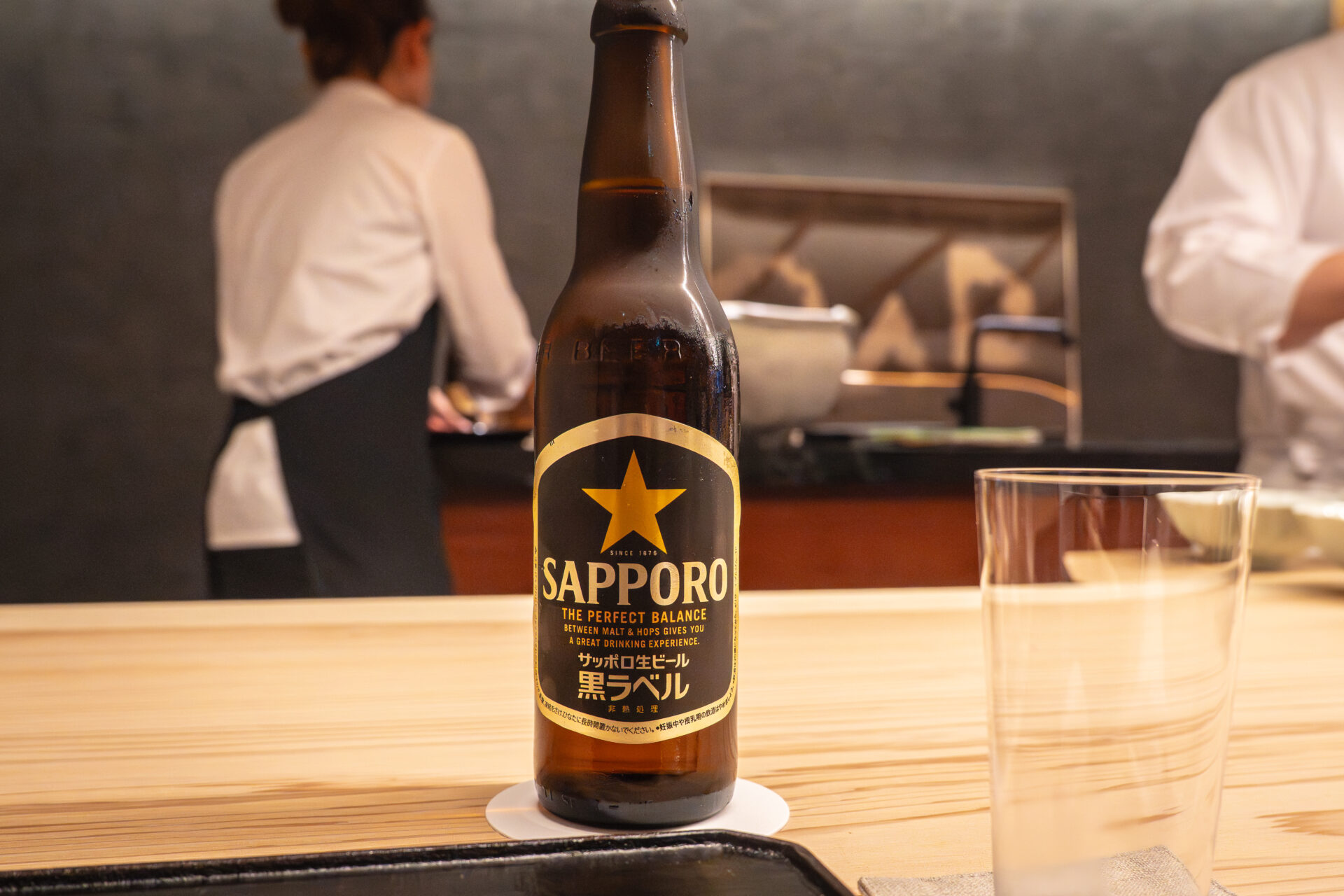
Dishes Tasted
Hairy Crab from Funka Bay and Loquats from Motegi, Nagasaki
The course began with peak-season kegani (hairy crab) from Funka Bay, Hokkaidō—plump, richly sweet, and deeply flavorful. Paired with it were freshly harvested loquats from Motegi in Nagasaki, their gentle, juicy sweetness complementing the crab’s depth without overwhelming it.
A light, thickened dashi was poured over the top, softly enveloping the umami and drawing you instantly into the world of the season from the very first bite.
The dish was garnished with a blade of iris, symbolizing a sword in honor of Tango no Sekku (Children’s Day), adding a thoughtful seasonal touch.
It was a serene and heartwarming start, soothing both palate and spirit.
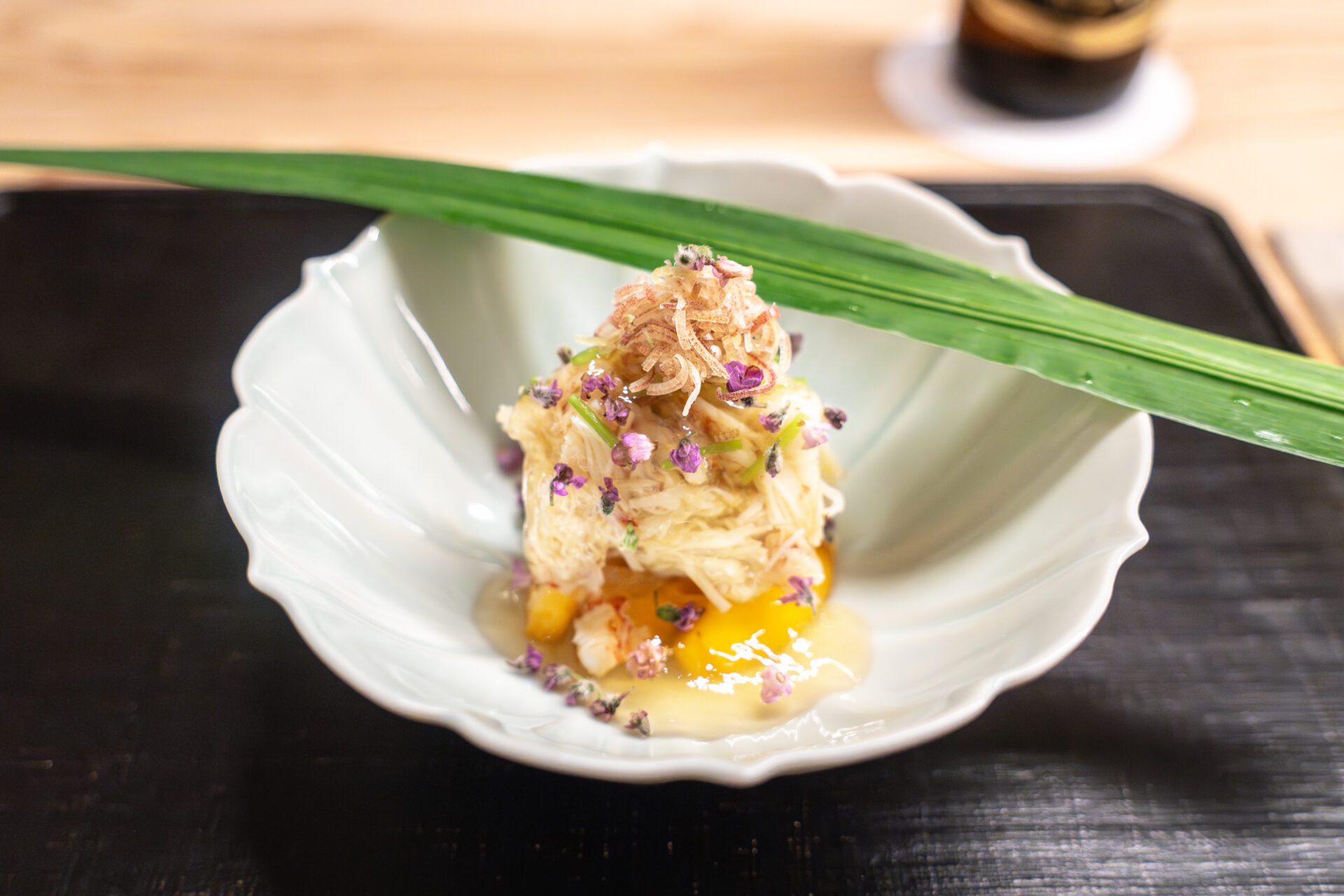
Interlude: Shiny White Rice with White Shrimp and Aged Karasumi
Next came a small rice dish prepared with Hinohikari rice from the chef’s hometown, Gojō in Nara. Cooked in a clay pot, the aroma alone invited stillness and attention.
Layered on top was seasonal shiro-ebi (white shrimp) from Toyama Bay—known for their rare, delicate sweetness—melting into the warm rice with elegant ease.
A spoonful of house-made karasumi (salted mullet roe), aged over two years and gently rehydrated with sake, added a deep umami note. Crowned with a small scoop of caviar, the dish revealed nuanced layers of saltiness and richness.
This interlude was quietly expressive—a humble canvas of rice accentuated by the treasures of the sea and the patience of time.
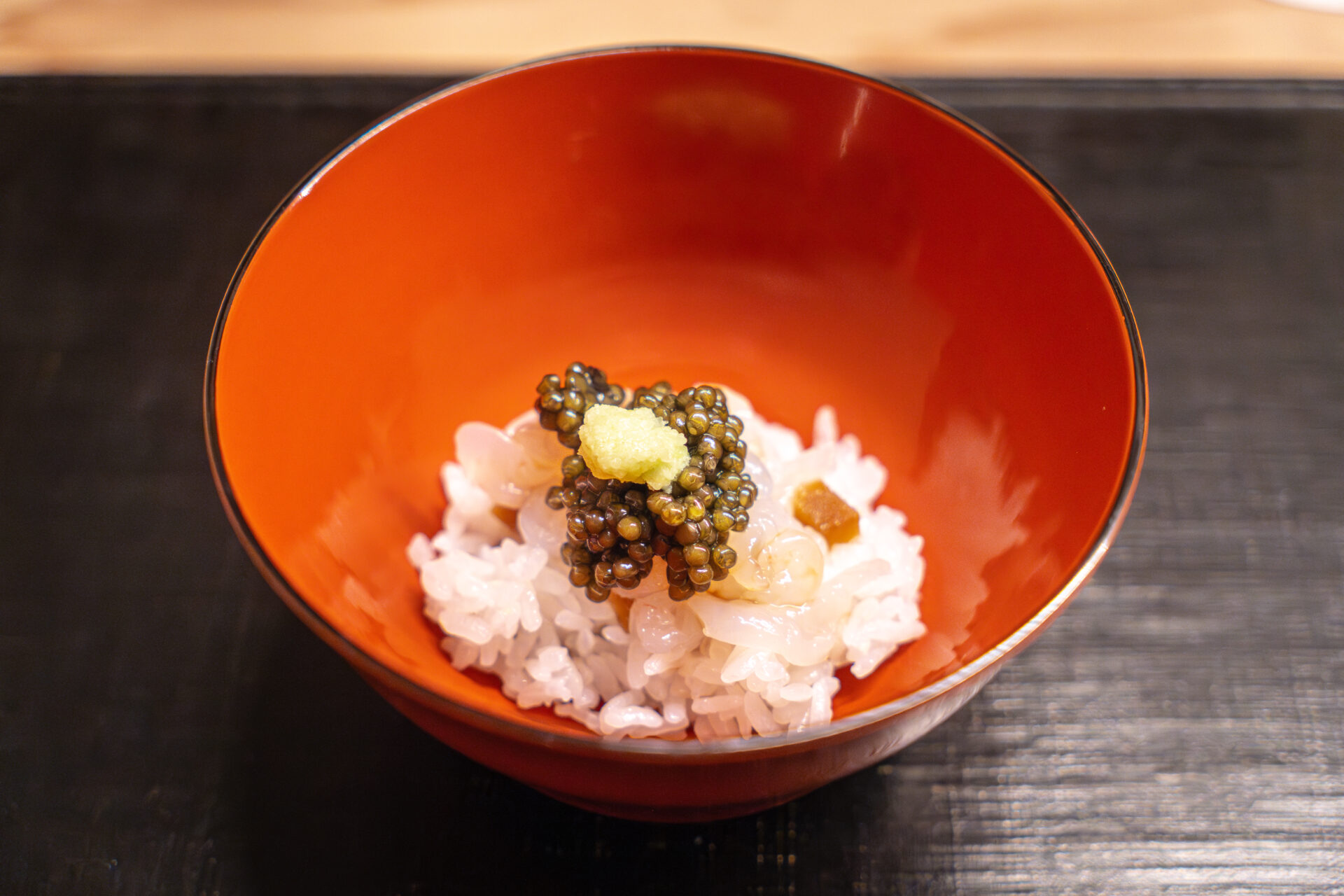
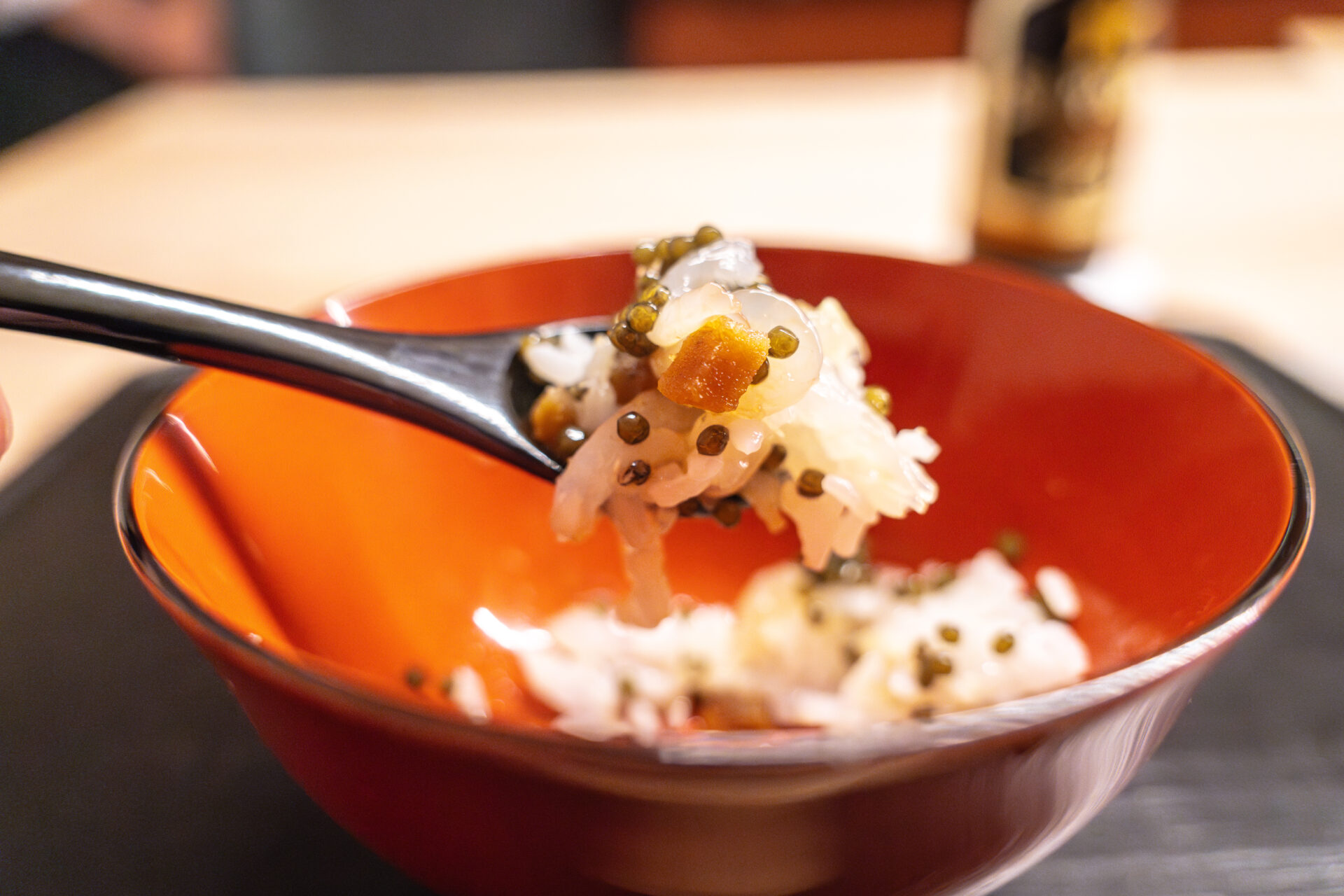
Soup: Green Pea Dashi with Charcoal-Grilled White Tilefish
A spring-scented bowl, featuring freshly shelled usui peas from Gojō, smoothly blended into a pale green dashi. Its gentle sweetness and soothing aroma calmed the senses as you leaned over the bowl.
At the center, a piece of shirakodai (white tilefish) from Shishikui, Tokushima, grilled over charcoal. The skin was crisp and aromatic, the interior moist and tender, its flavor naturally fusing with the mellow green pea broth.
Hidden underneath, a gently set tamago-dōfu (egg custard) added a soft contrast.
Each element merged into a unified expression of spring—subtle, layered, and deeply comforting.

Sashimi ①: Ainame from Akashi, Lightly Seared Shabu Style
The first sashimi course featured ainame (fat greenling) from Akashi, flash-seared in hot oil in a shabu-shabu-inspired preparation.
Skillfully processed with shinkei-jime for optimal freshness, the fish was perfectly seared on the surface while remaining translucent at the core. The texture was meltingly soft, the flavor delicate and rounded.
Accompaniments included grated daikon laced with ume and a touch of wasabi—balancing the richness with gentle acidity and spice.
Served in a pale blue porcelain dish, the composition was quiet but striking. Every aspect—aroma, temperature, and flavor—was thoughtfully calibrated.
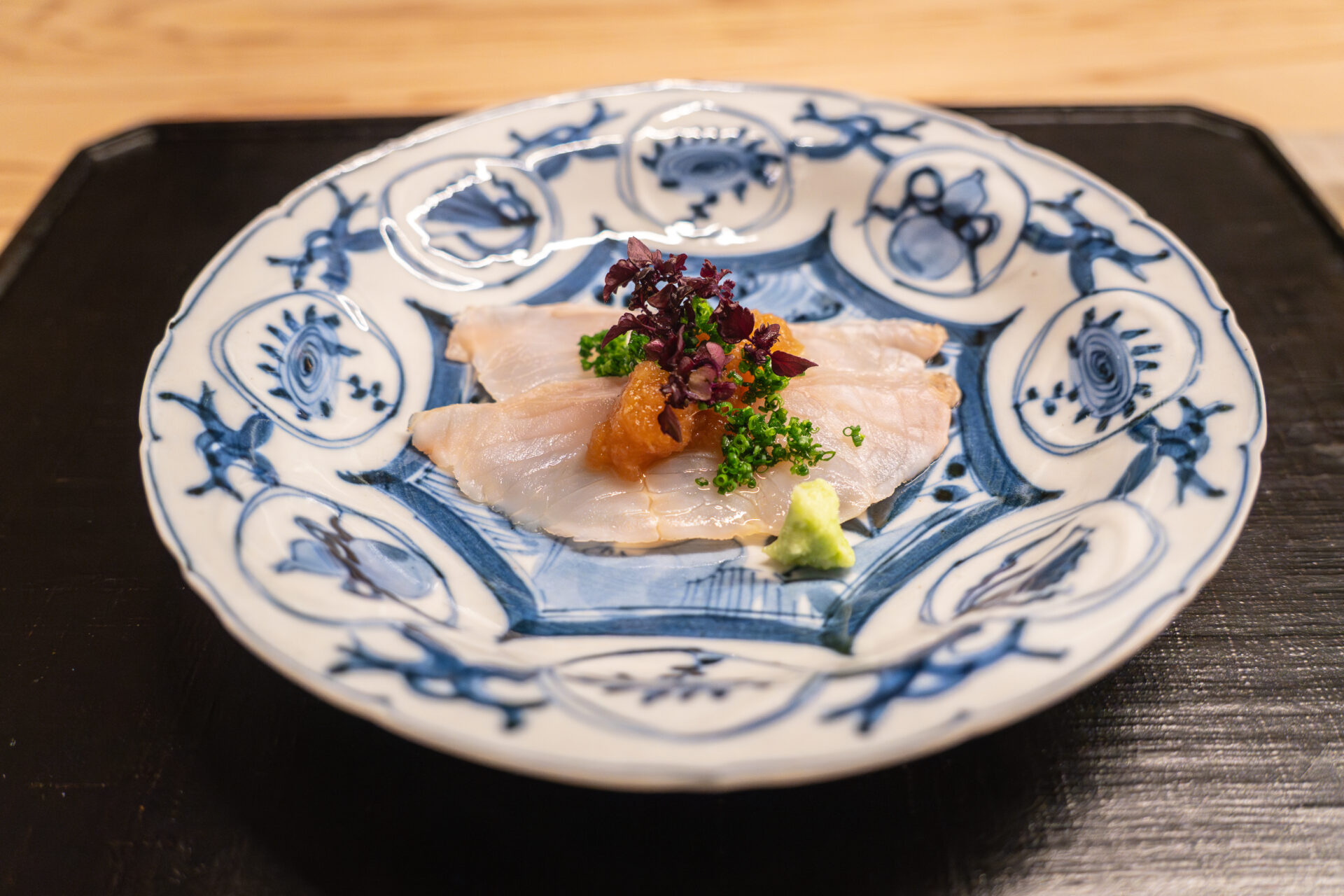
A summer-only sake, “Yokoyama Natsu Jun-Gin” from Shōya Shuzō, a unique distillery on Iki Island producing both shōchū and sake, accompanied the dish.
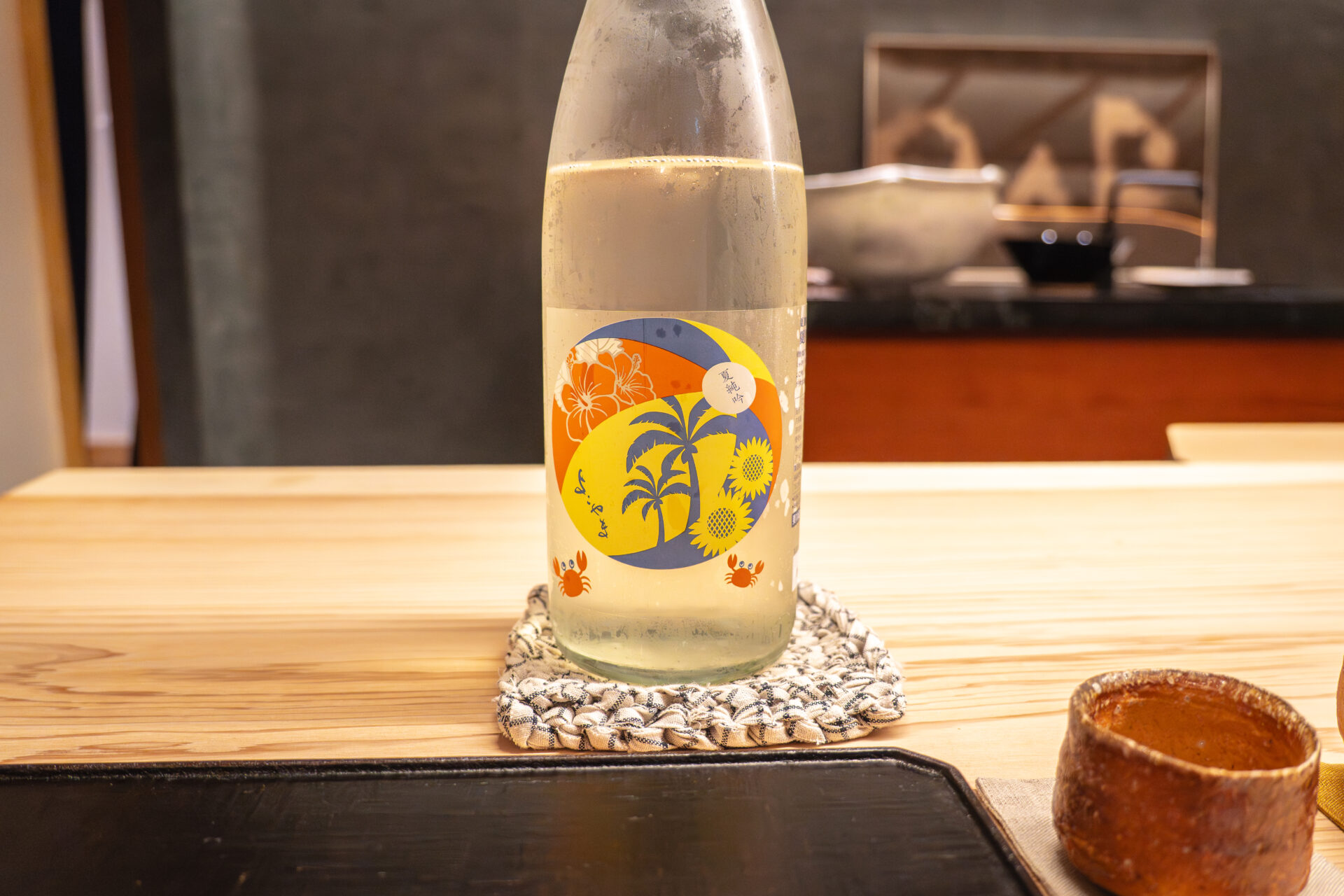
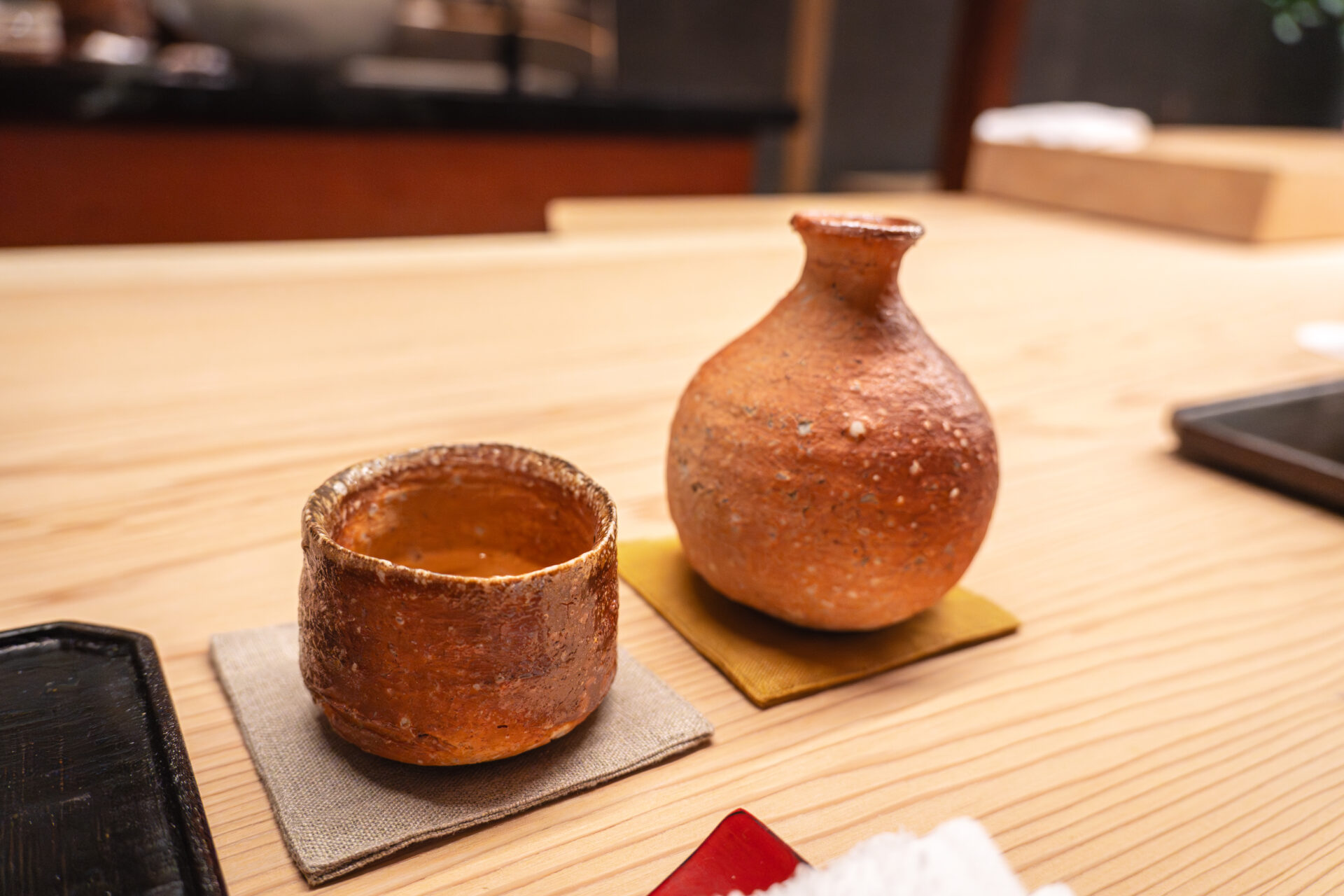
Sashimi ②: Setouchi Horse Mackerel with Golden Sesame
Next was sezuki aji (horse mackerel that stays close to shore) from Suō-Ōshima, Yamaguchi. Thick, fatty, and skillfully sliced, the fish offered a refined richness that gently melted in the mouth.
It was generously coated with rare golden sesame—cultivated by the only grower in Gojō—which released a deep, toasty aroma with every bite.
Finely chopped aromatic vegetables were lightly layered on top, adding freshness and balancing the sesame’s richness and the fish’s fat.
The dish, reminiscent of a aemono (dressed salad), showcased a harmonious blend of aroma, texture, and umami, all within a single, satisfying mouthful.
It was sashimi, yet it pushed the boundaries—expressing range and creativity while remaining grounded in tradition.
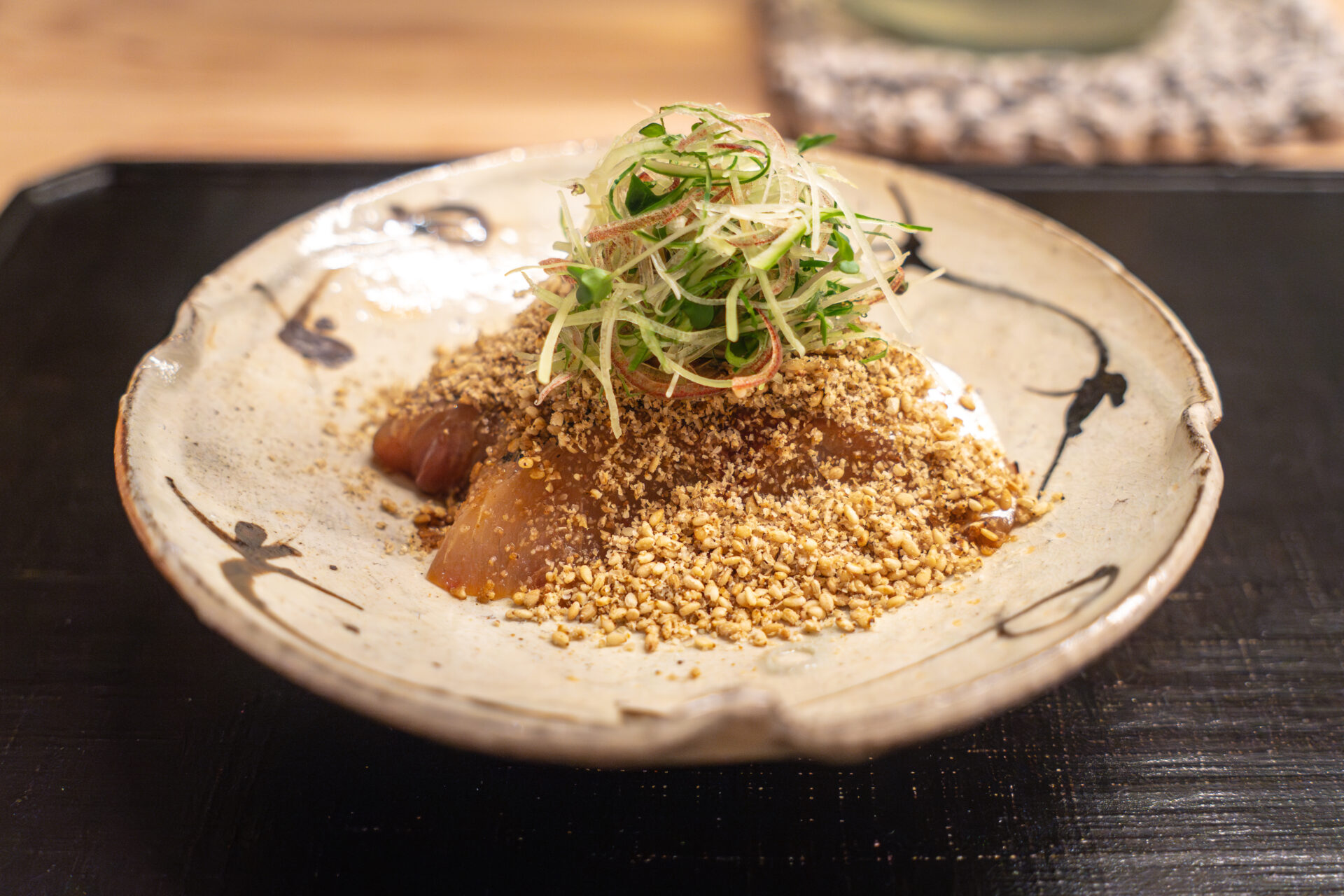
Fried Dish ①: Fava Beans and Scallops from Notsuke Peninsula
The first fried course offered a simple yet memorable pairing: freshly picked fava beans from Gojō and wild scallops from Notsuke Peninsula, Hokkaidō.
The scallops were prepared over two days in a manner similar to a light overnight drying—not overly dehydrated, just enough to concentrate their umami while retaining moisture.
Encased in a delicate coating, the tender fava beans and richly sweet scallops nestled together in perfect harmony. With each bite, their respective aromas gently rose and mingled.
Seasoned only with salt, the dish let the natural characteristics of the ingredients shine clearly. It was quiet in presentation, yet powerful in presence—a dish that spoke through restraint.
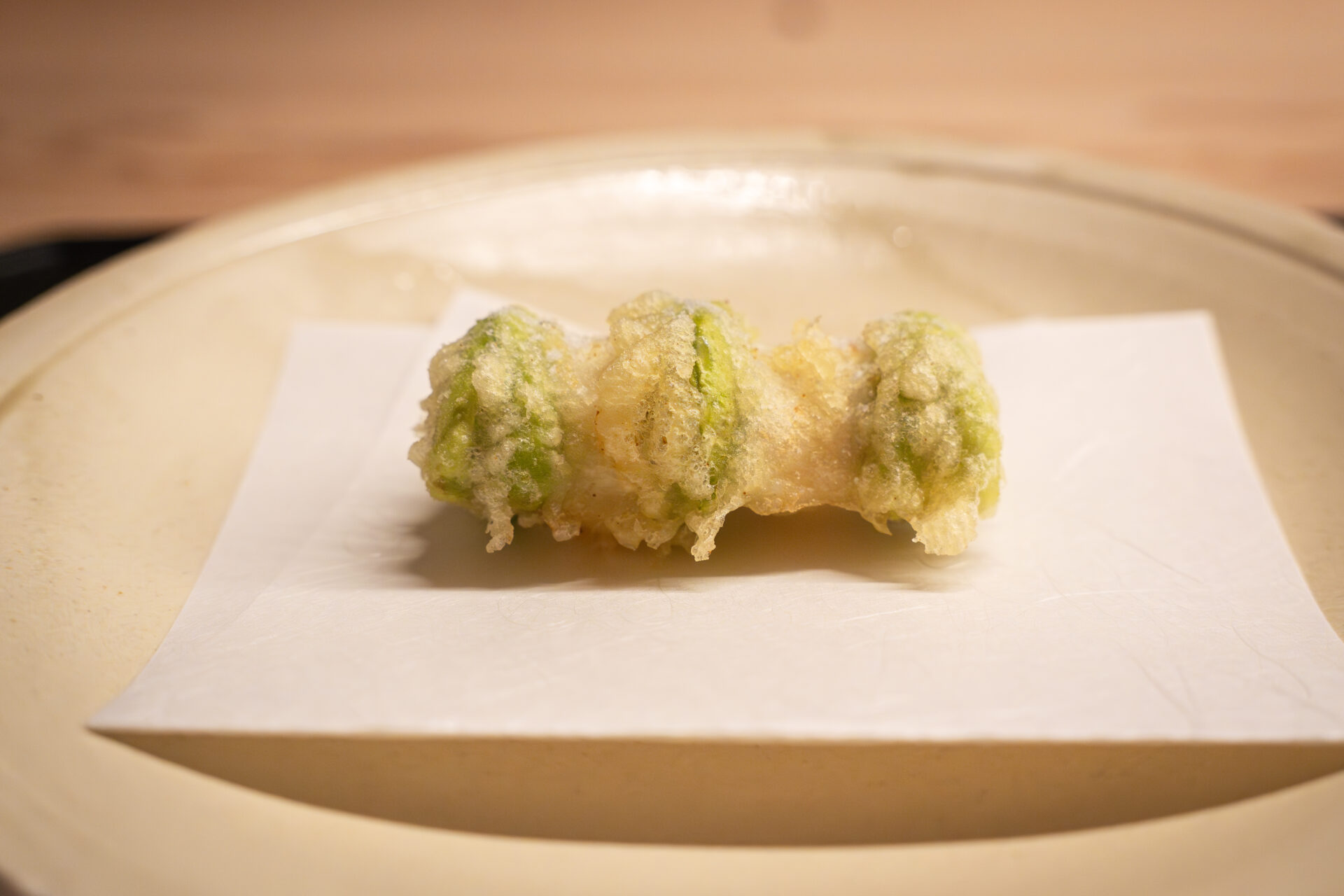
Fried Dish ②: Anago from Tsushima with Green Yuzu
The second fried dish featured thick, luscious anago (sea eel) from Tsushima, Nagasaki. The eel was first simmered to a soft, almost melting tenderness, then gently battered and fried as tempura.
The moment you bite in, the exterior crisps with a light crunch while the inside releases a rush of savory juices. The contrast between the simmered eel’s softness and the fried coating’s fragrance was truly indulgent.
To finish, a generous grating of green yuzu zest was added on top. Its vibrant citrus aroma lifted the dish, leaving a refreshing, elegant aftertaste that offset any heaviness from the fry.
This was a dish where the ingredient’s innate quality, meticulous preparation, and a final aromatic touch all came together—a memorable expression of harmony and care.
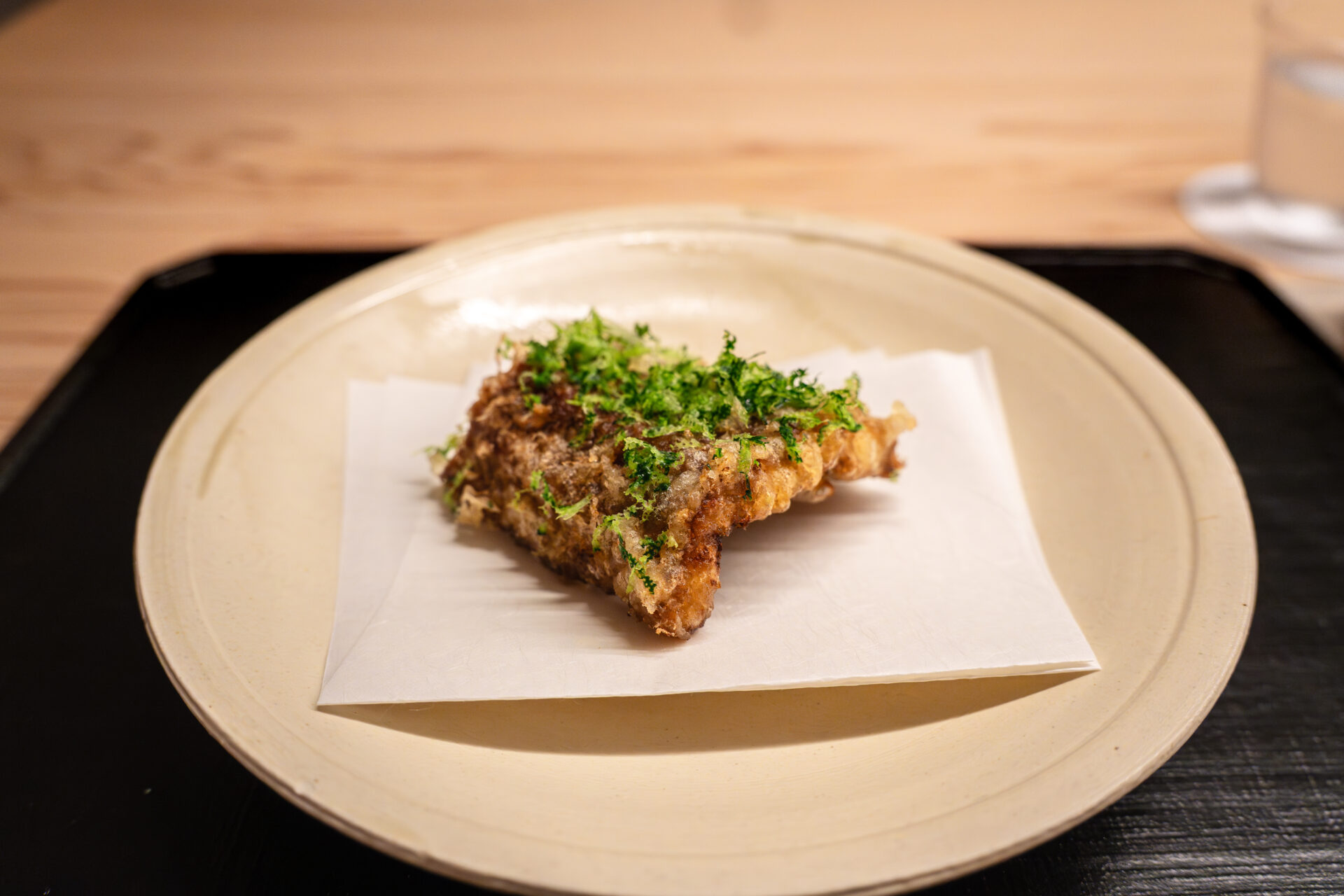
Grilled Dish: Torigai from Kumihama with Liver Soy Sauce and Sanshō Aroma
Over the gentle heat of binchōtan charcoal, Chef Hirooka slowly grilled thick, plump torigai (Japanese cockle) from Kumihama in the Tango region of Kyoto. Watching it cook right before your eyes allowed for a multisensory experience—feeling the warmth, witnessing the transformation, and inhaling the changing aromas.
The grill was a handmade ceramic hibachi crafted by Mr. Tsujimura of Nara. As the shellfish was grilled, the chef brushed it with sanshō-infused oil, releasing a delicate citrus-pepper fragrance that perfectly highlighted the natural sweetness of the torigai.
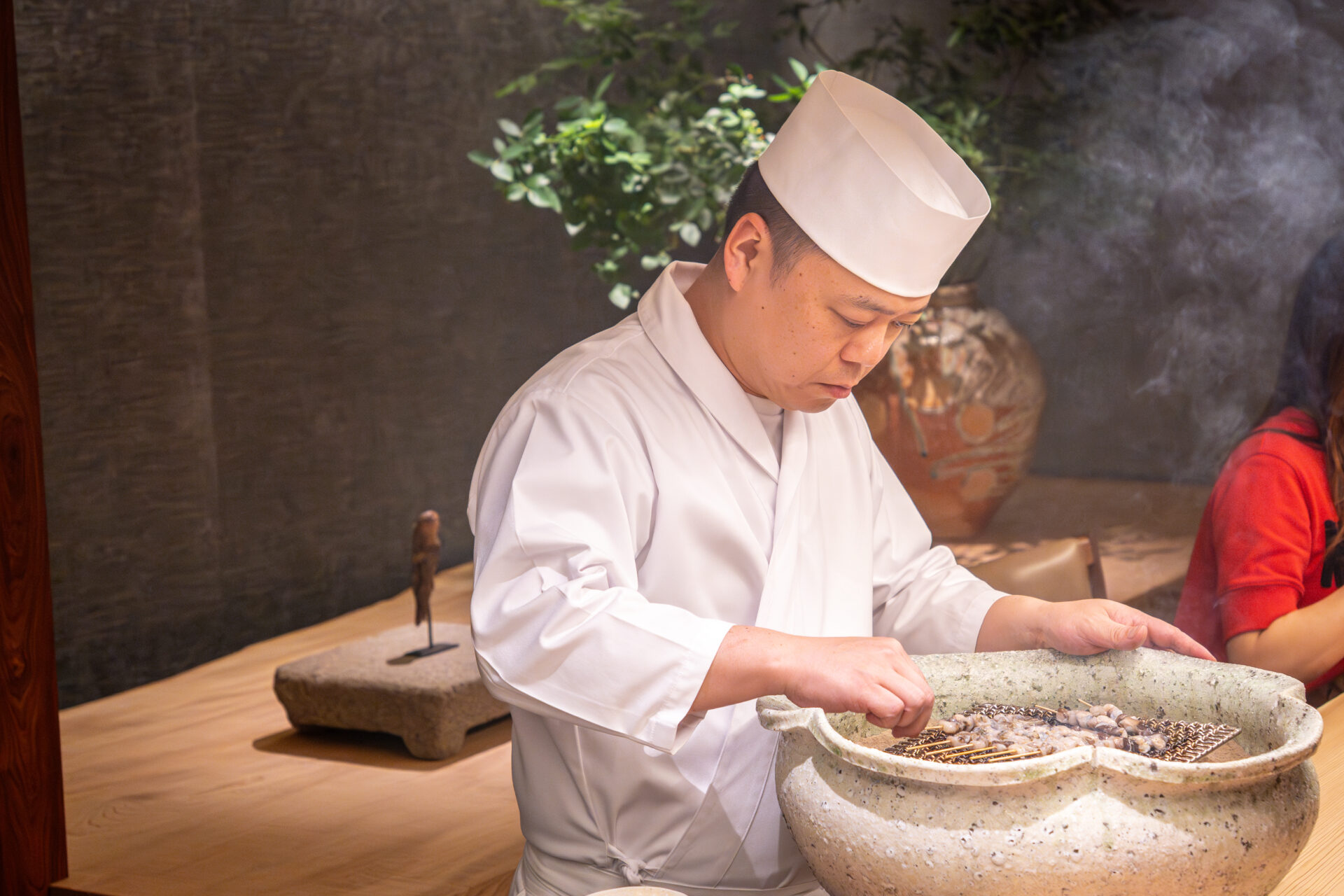
To finish, he applied a light glaze of house-made liver soy sauce made from the torigai innards. Rich umami, faint bitterness, and a deep roasted aroma came together in a dish that was minimalist yet complete.
Even its presentation—neatly skewered—left a lasting impression, a refined highlight of the grilled course.
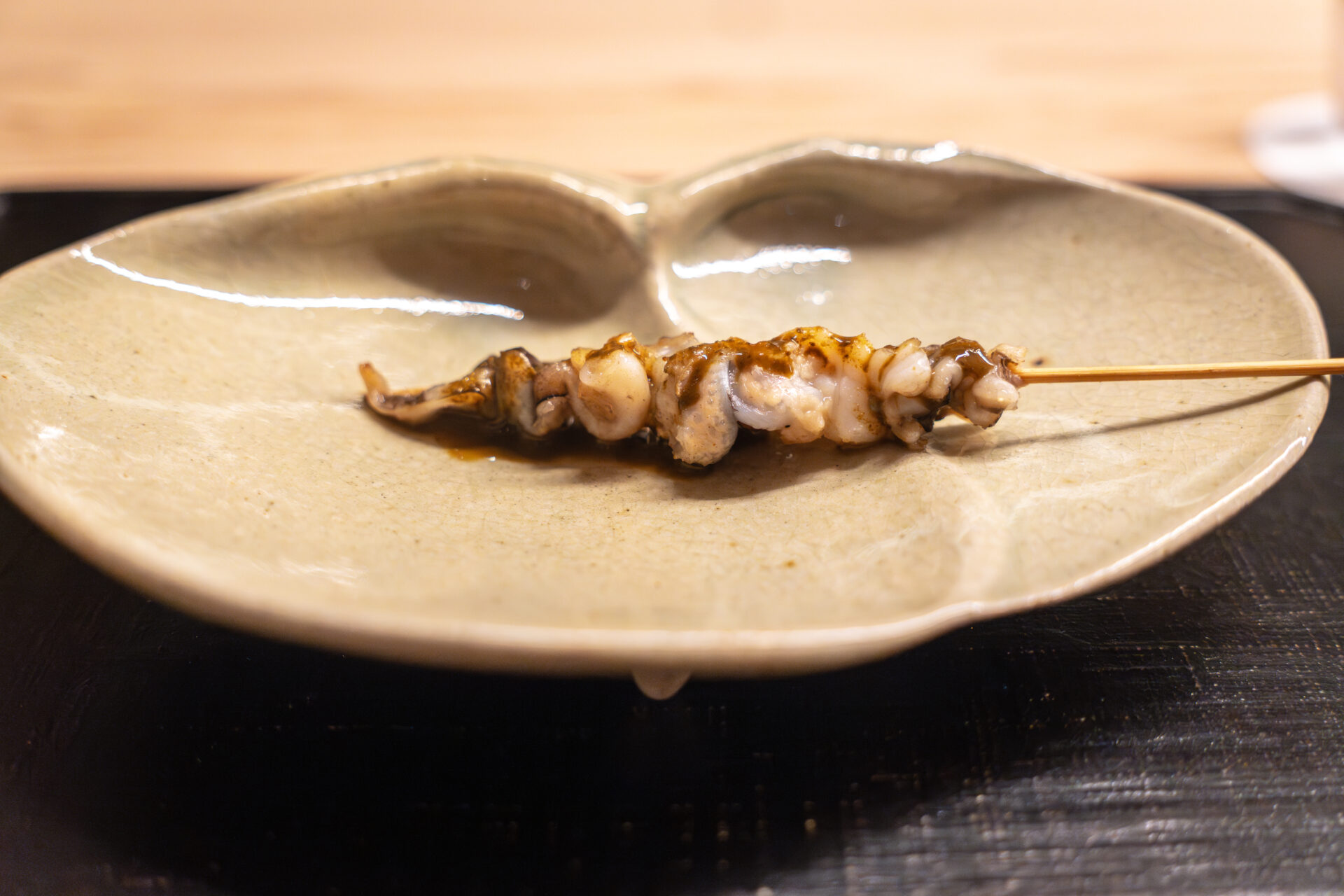
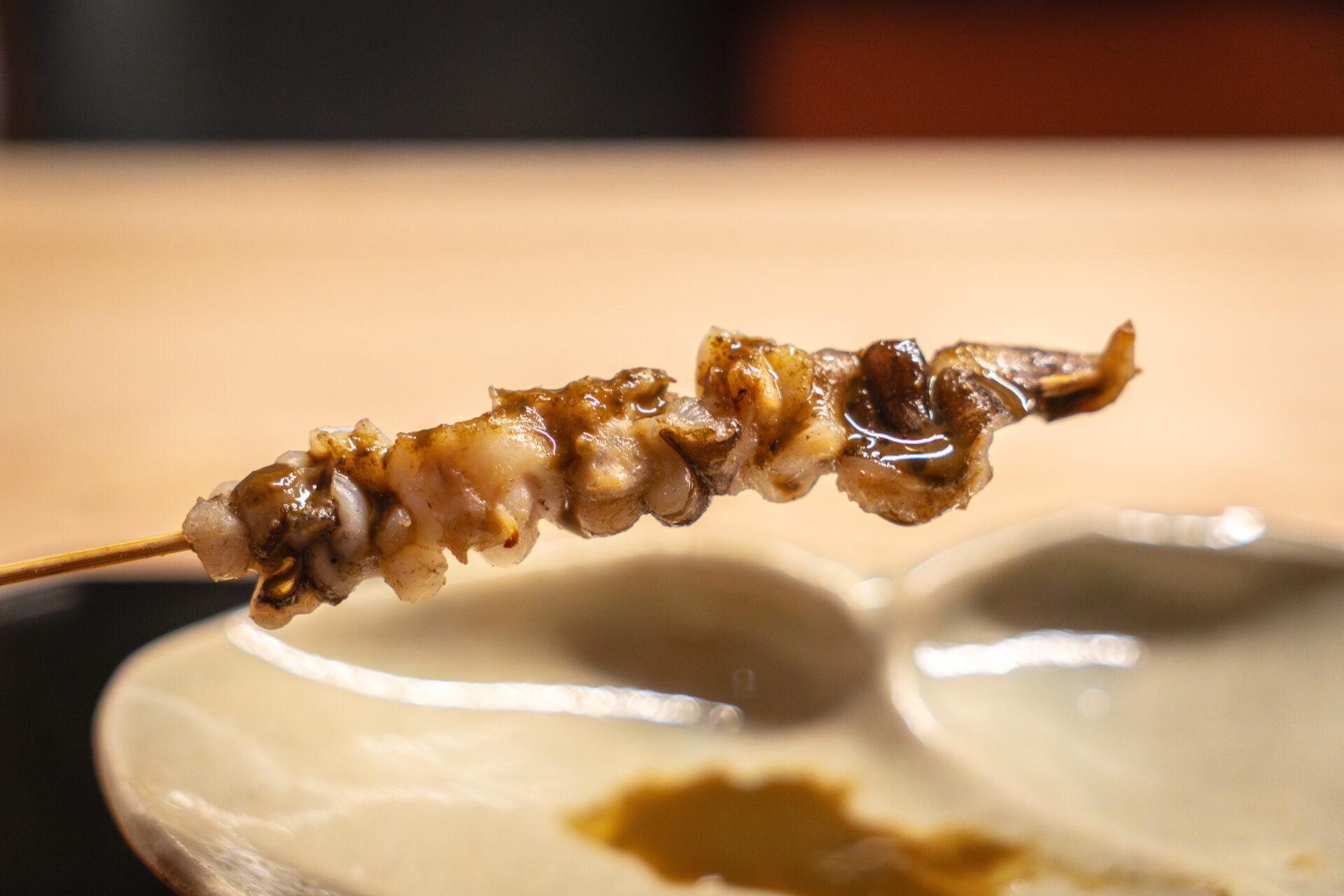
Palate Cleanser: Miwa Sōmen “Shiraga” with New Ginger Dashi and Grilled Eggplant
To gently transition from the grilled course, a refreshing palate cleanser was served: “Shiraga,” an ultra-fine aged sōmen from Miwa Yamamoto in Nara, matured for three years. True to its name (“white hair”), the noodles were delicate as silk threads, lightly floating in a refined broth.
The dashi, subtly flavored with new ginger, warmed gently from within as you sipped it. Nestled within were soft slices of grilled eggplant and a hint of junsai (water shield) from Akita, adding both texture and nuance.
This was not a sharp or chilled palate cleanser, but rather one defined by softness and restraint—a quiet pause that prepared the senses for what was to come.
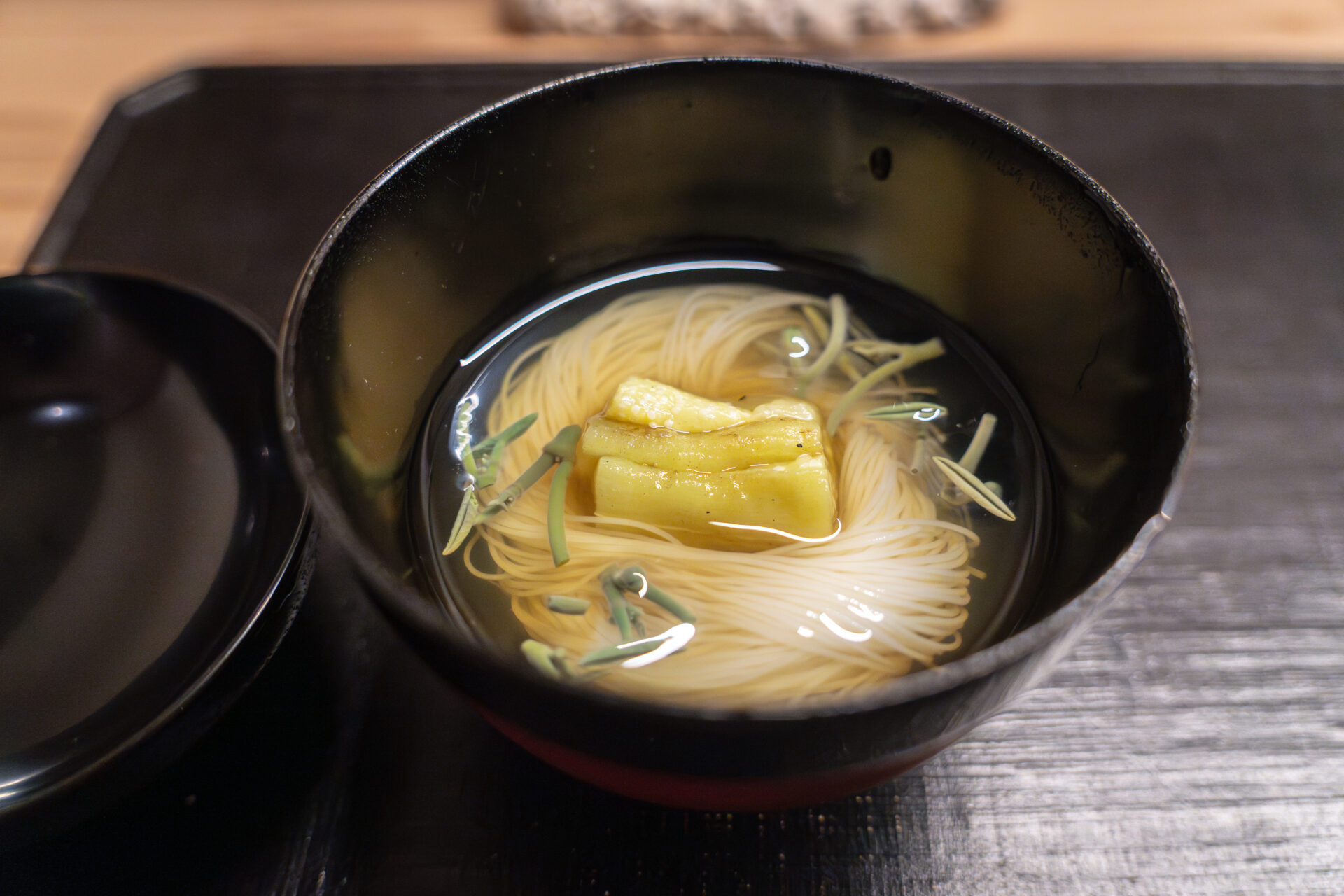
Paired alongside was “Yamasan Junmai Daiginjō Aiyama 45” from Miyoshino Brewery in Nara. Brewed from Aiyama rice polished to 45%, its lush fullness and crisp finish made it an ideal companion during the meal.
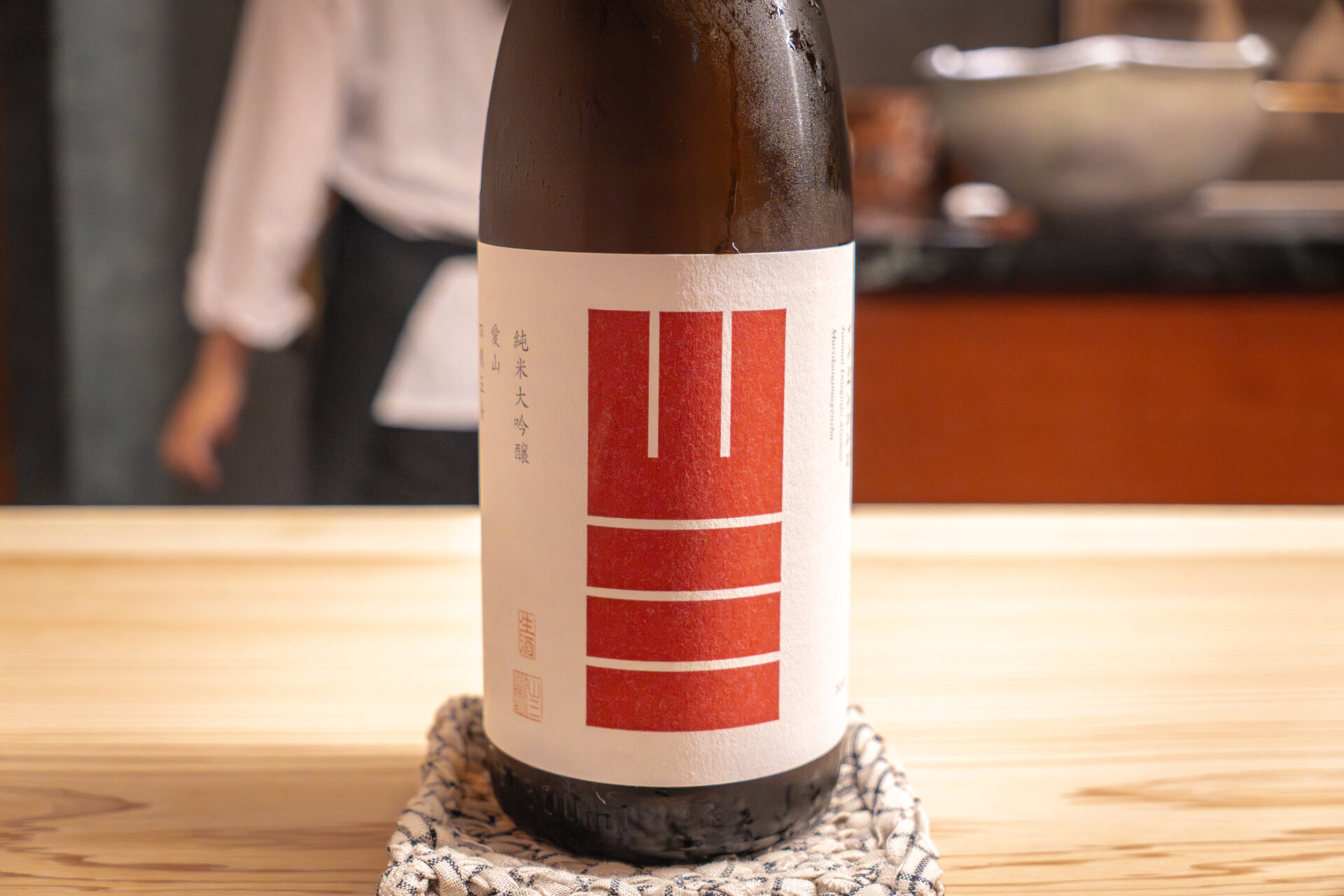
White Miso Soup: Hanazanshō and Fresh Whale Tongue (Saezuri)
A spring-inspired bowl, where mellow white miso broth was adorned with floating sprigs of hanazanshō (young sanshō flowers) from Gojō. The aroma alone invited you to lean in.
At the center was saezuri—the tongue of a minke whale, served raw. It had no trace of gaminess, just a supple texture and a distinctive richness. As you ate, the whale meat’s unique flavor melted into the sweet miso and was uplifted by the fragrant hanazanshō.
The key was to gather the hanazanshō with each bite. Its sharp, tingling scent cut through the roundness of the broth, giving structure to the otherwise mellow flavor.
Additional accents included the natural sweetness of white asparagus and the rustic earthiness of wild seri (Japanese parsley), offering balance and grounding the dish.
Altogether, this was a late-spring bowl—gentle, complex, and quietly lingering, without ever feeling heavy.
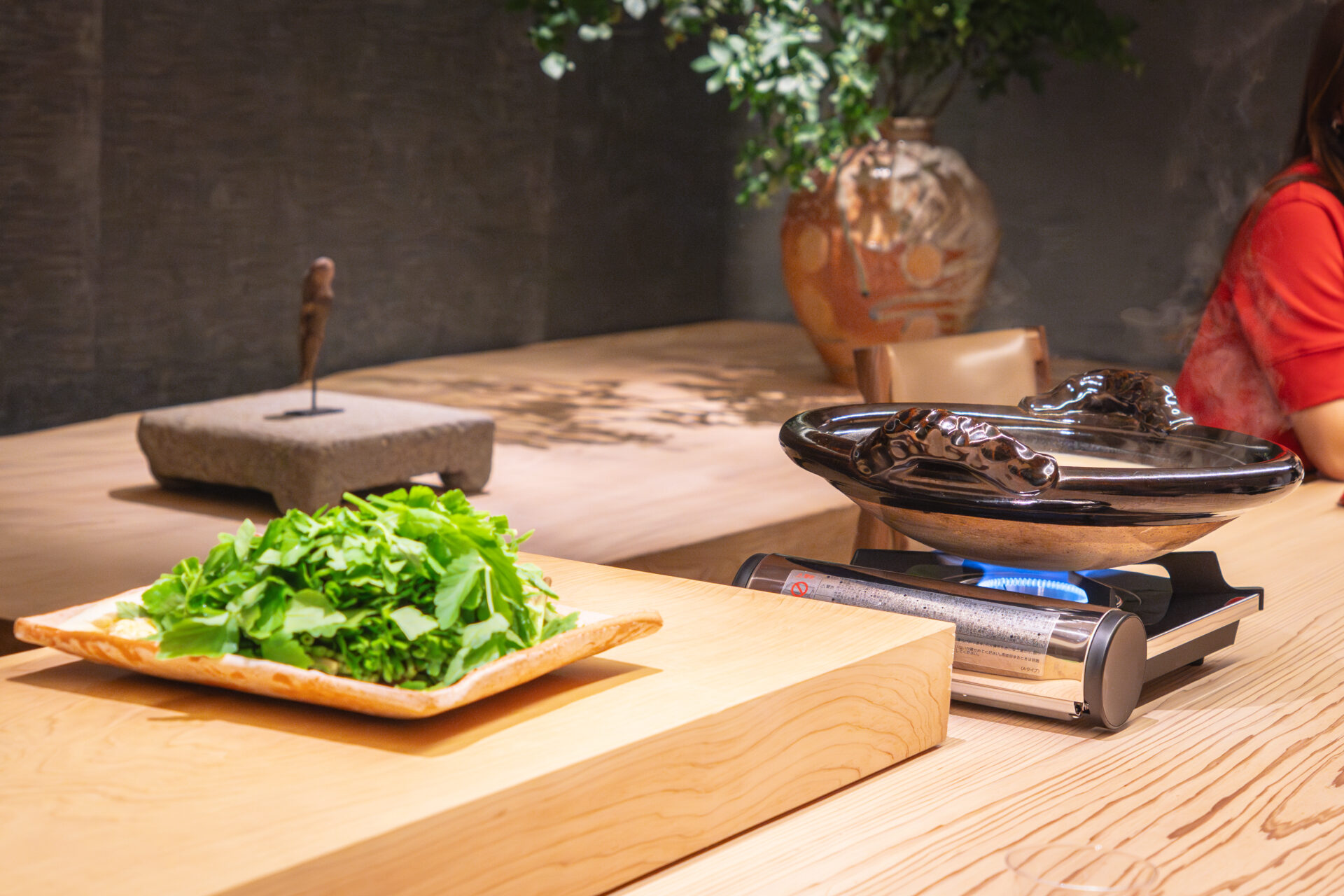
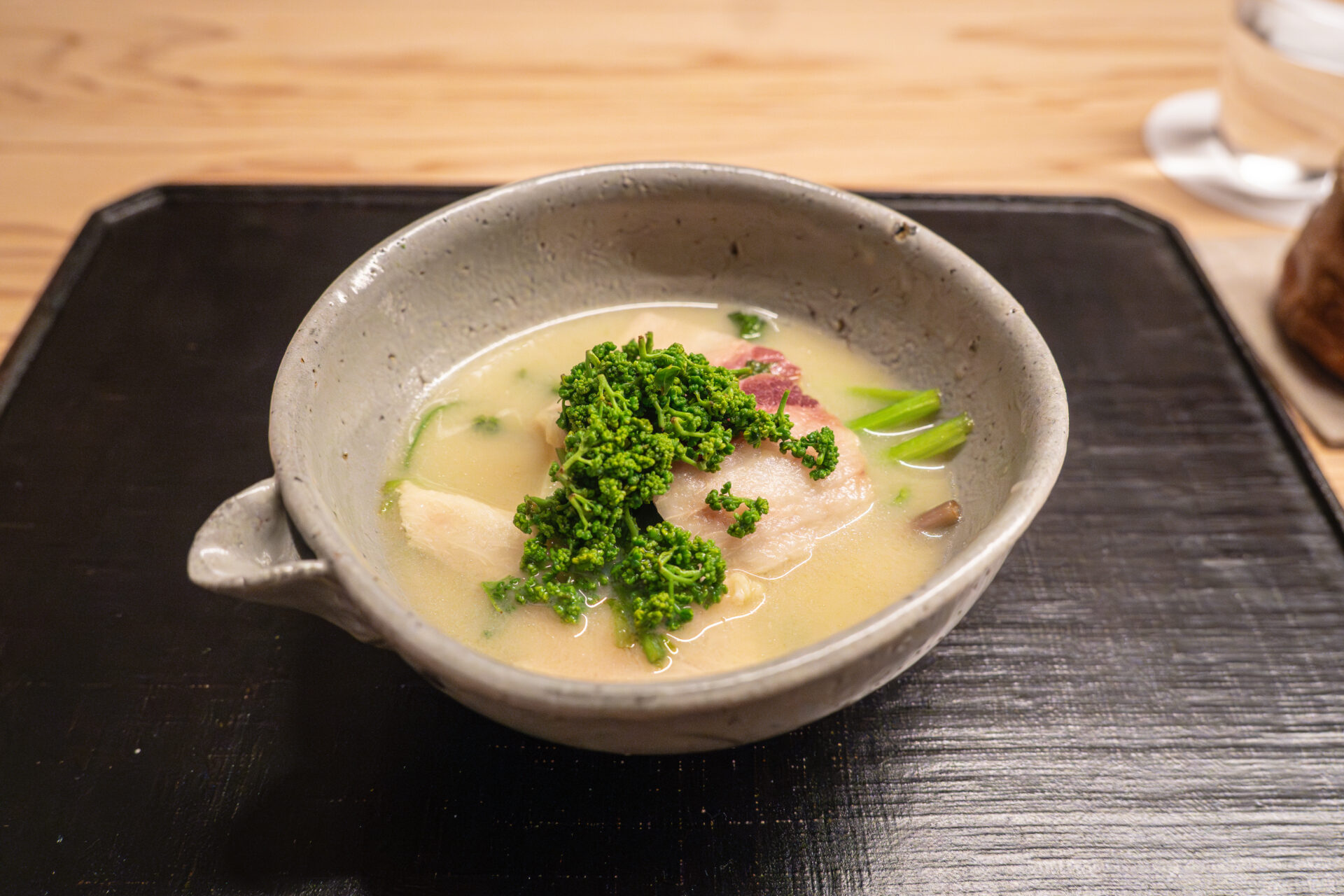
Final Rice Course: Shiny White Rice with Kama-age Shirasu
Though Oryōri Hirooka usually serves a seasonal takikomi gohan (rice cooked with seasonal ingredients) to close the meal, in May, there’s a special exception: freshly cooked ginshari (plain white rice) takes the spotlight.
The rice is Hinohikari from the chef’s hometown of Gojō. Steamed to perfection in a clay pot, the grains are plump, distinct, and lightly sweet, offering a pure and satisfying finish.
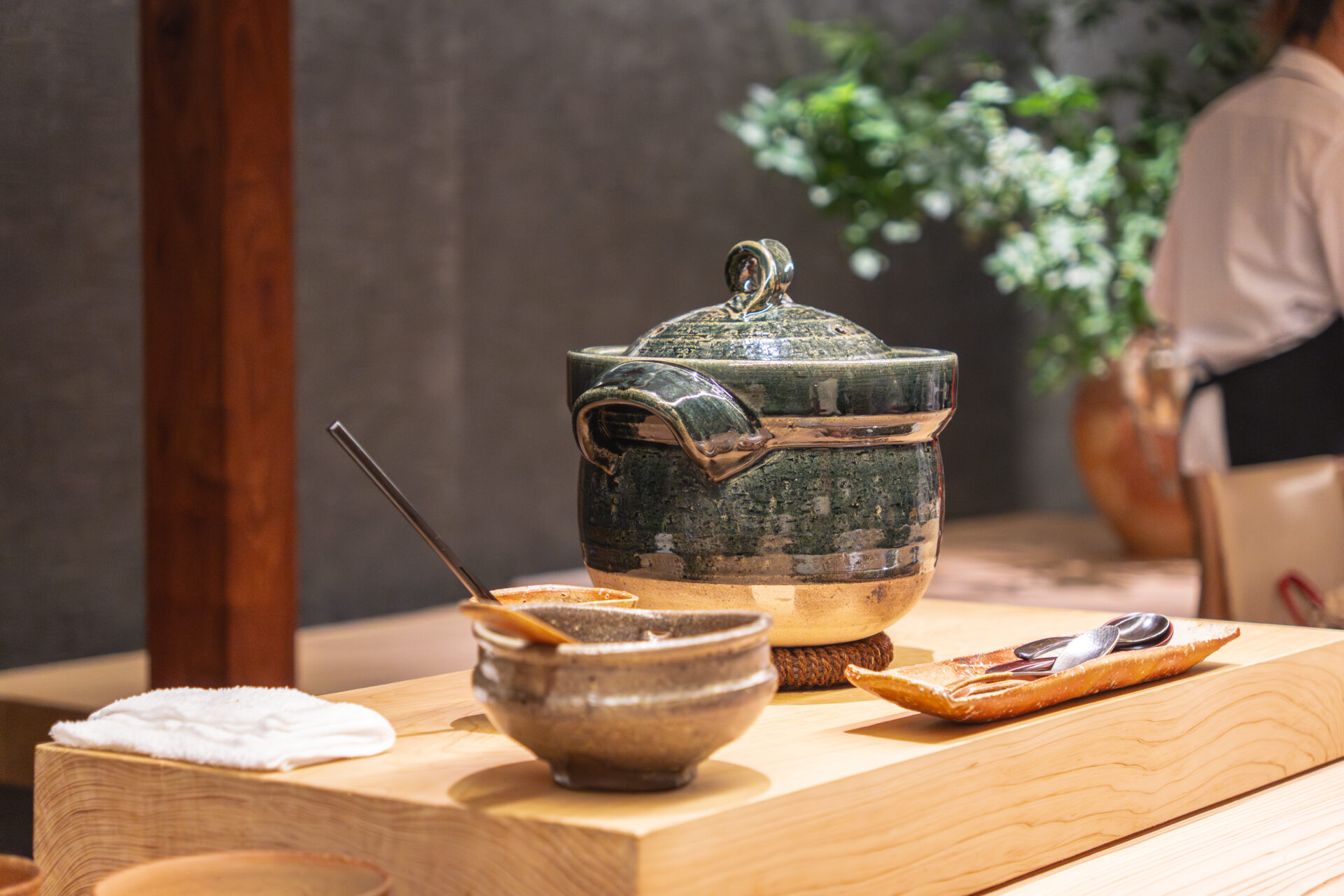
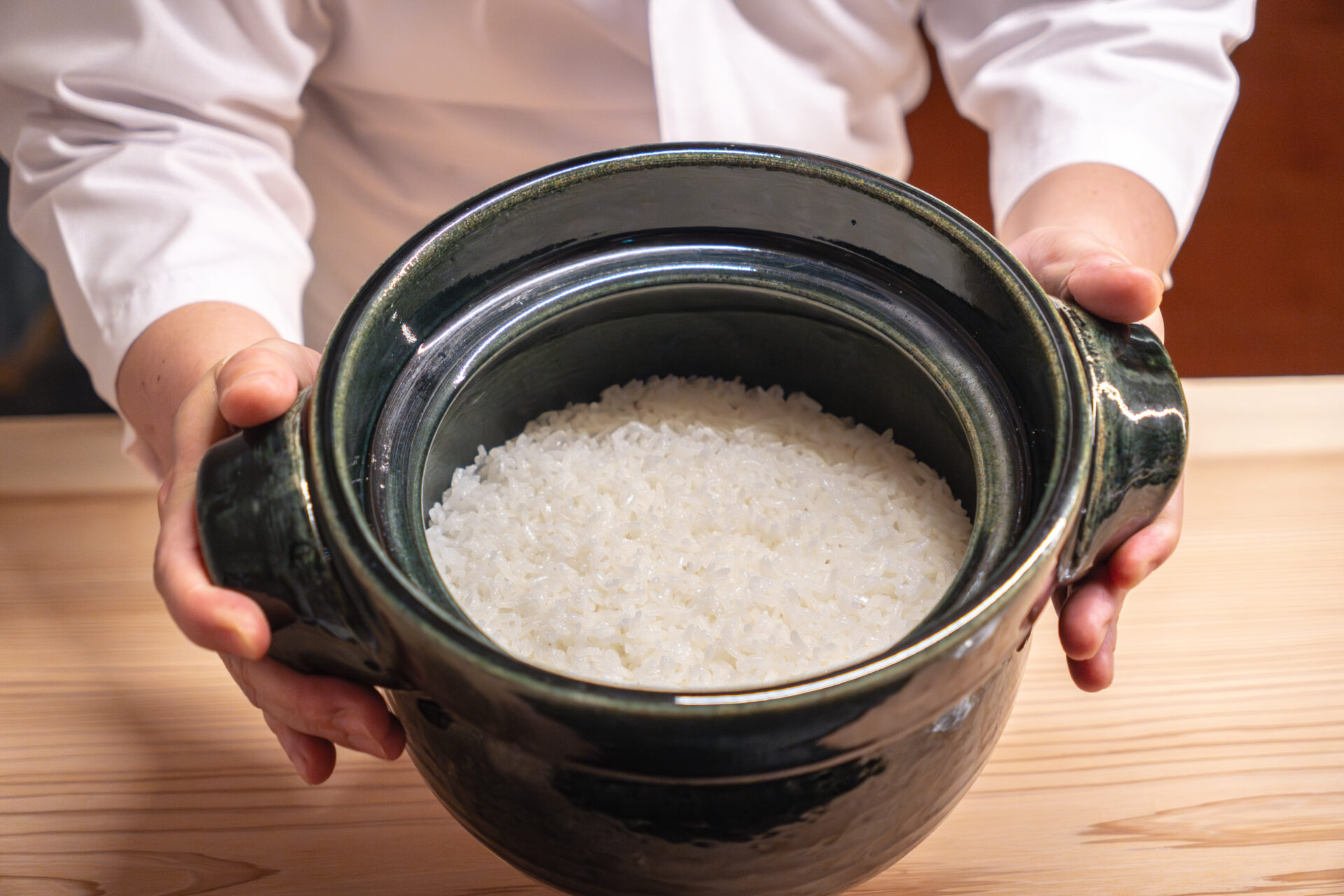
It’s paired with delicate kama-age shirasu (boiled young sardines) from Masutomi Shoten in Wakayama. Harvested using a closely guarded method, the shirasu are tender and fluffy, with a gentle aroma of the sea. Chef Hirooka himself calls them “the best shirasu in the universe”—and the taste lives up to the praise.
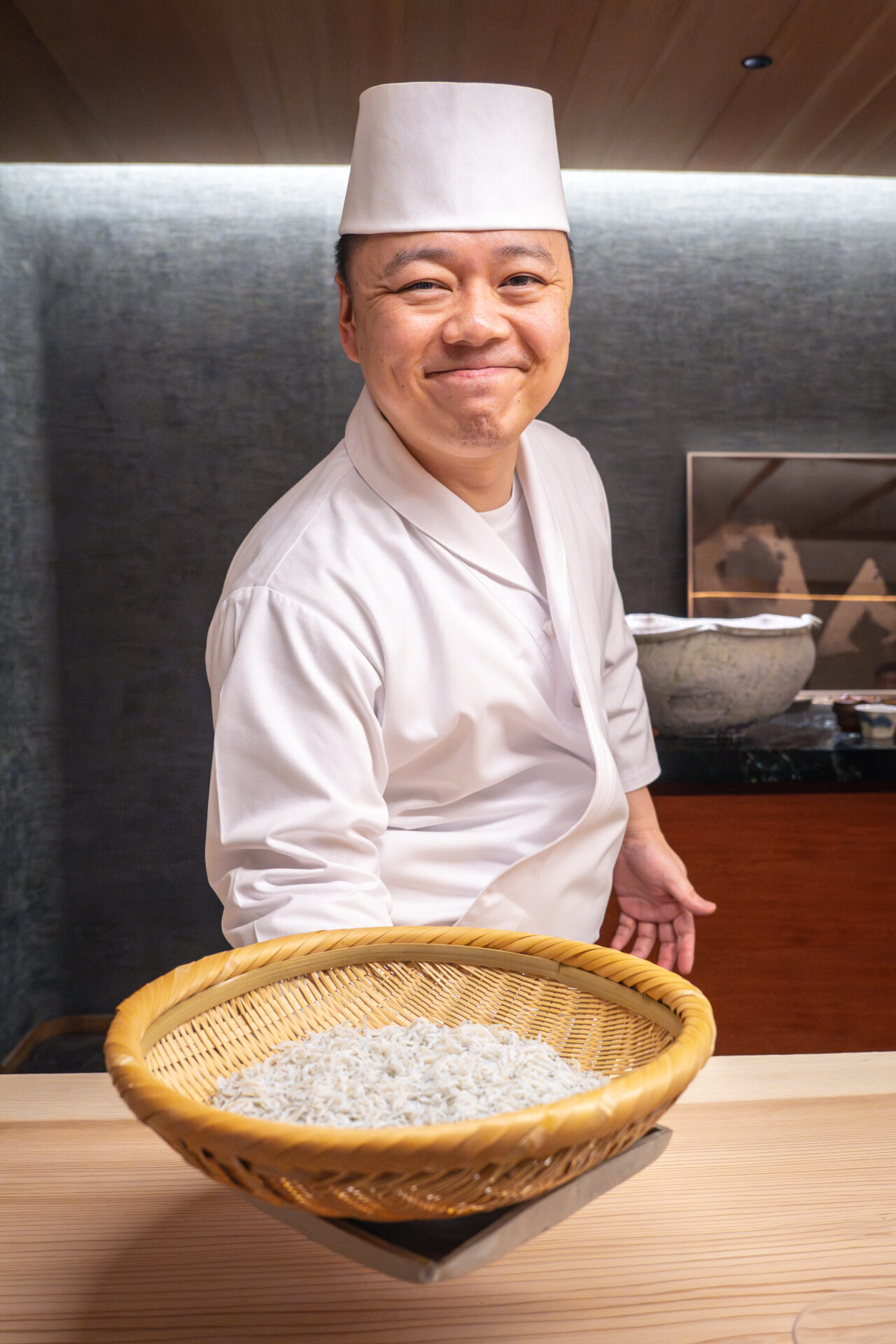
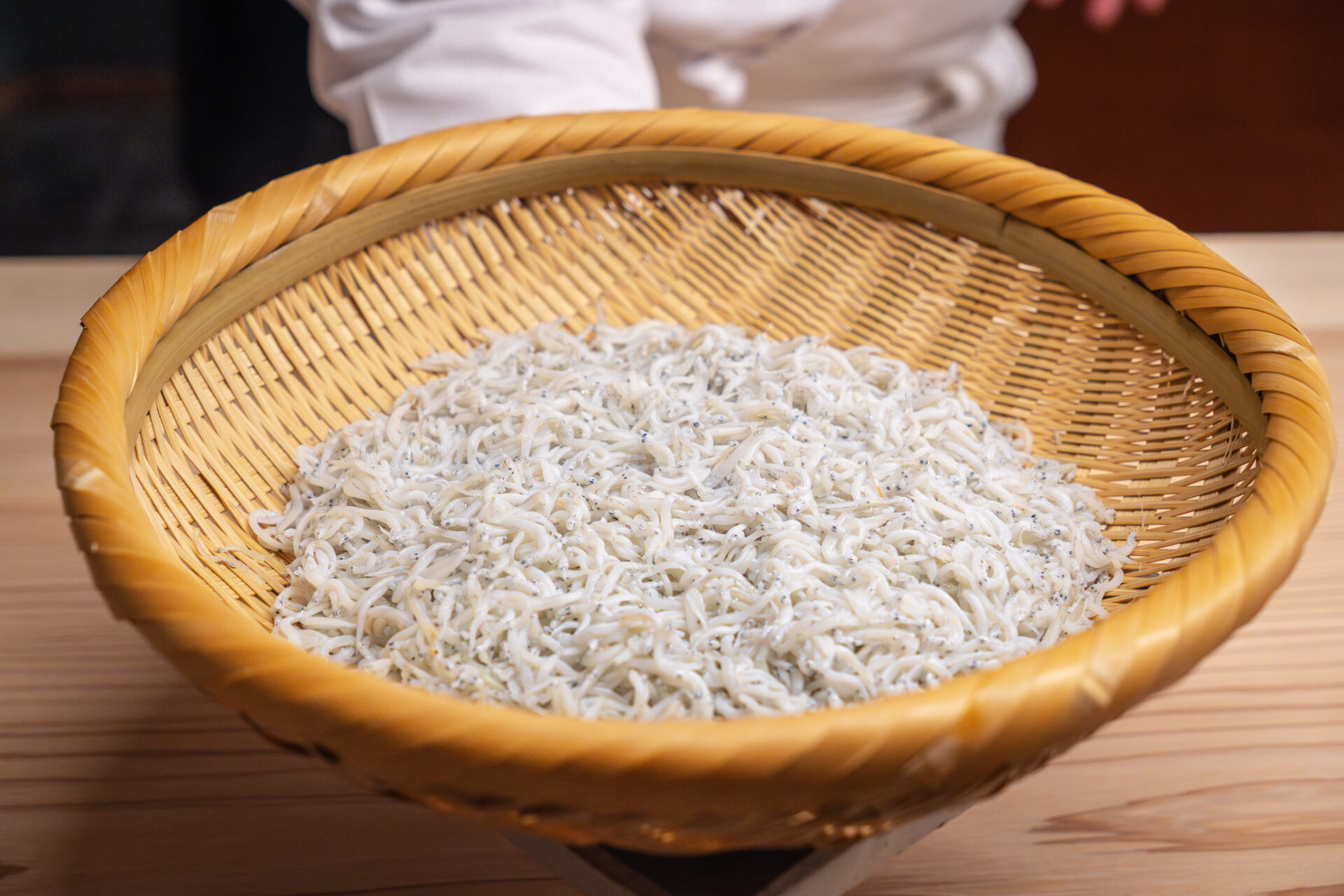
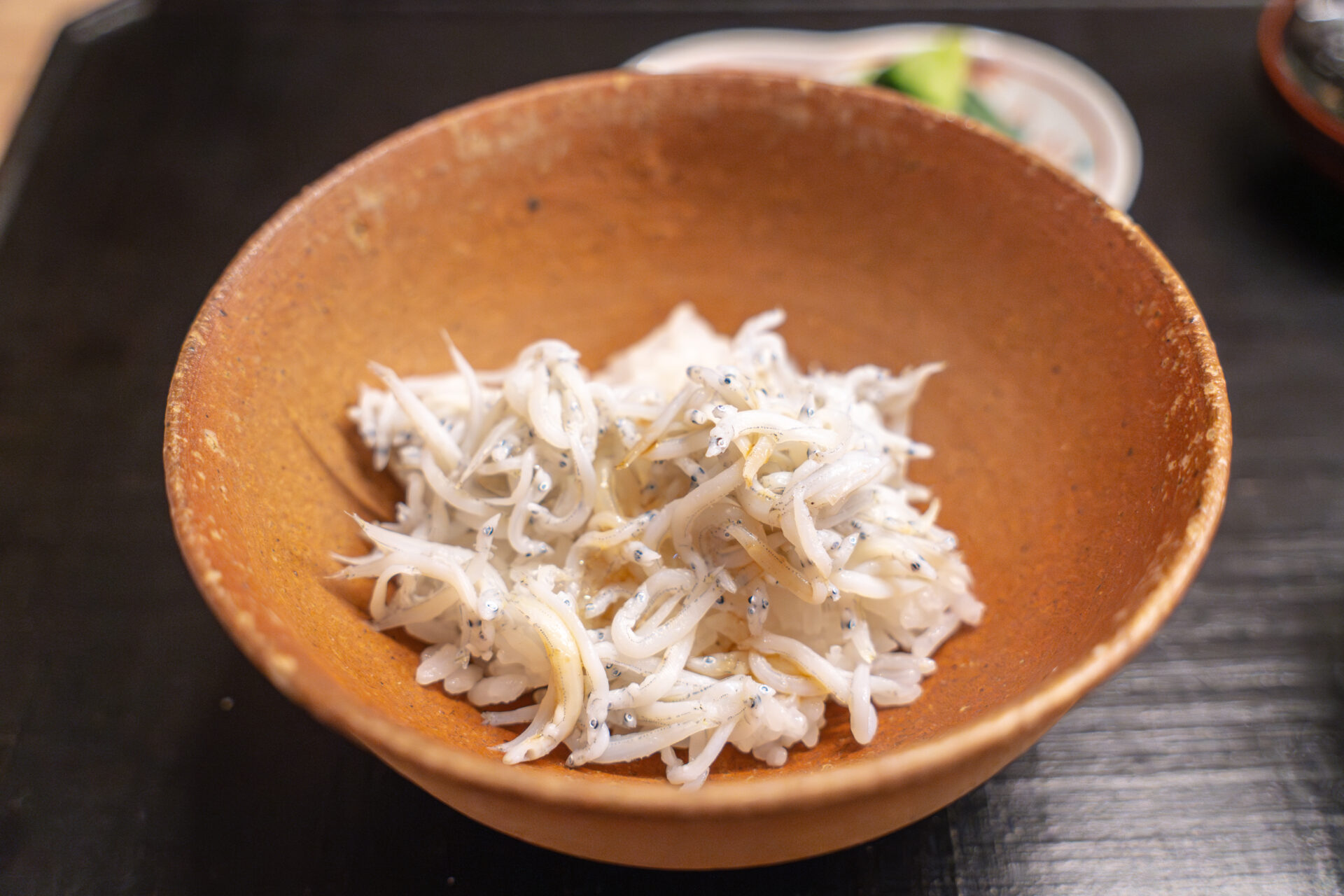
The first bowl is served with hanazanshō tsukudani (simmered sanshō buds). The fresh, peppery notes lift the umami of the shirasu, resulting in a simple yet deeply resonant dish.
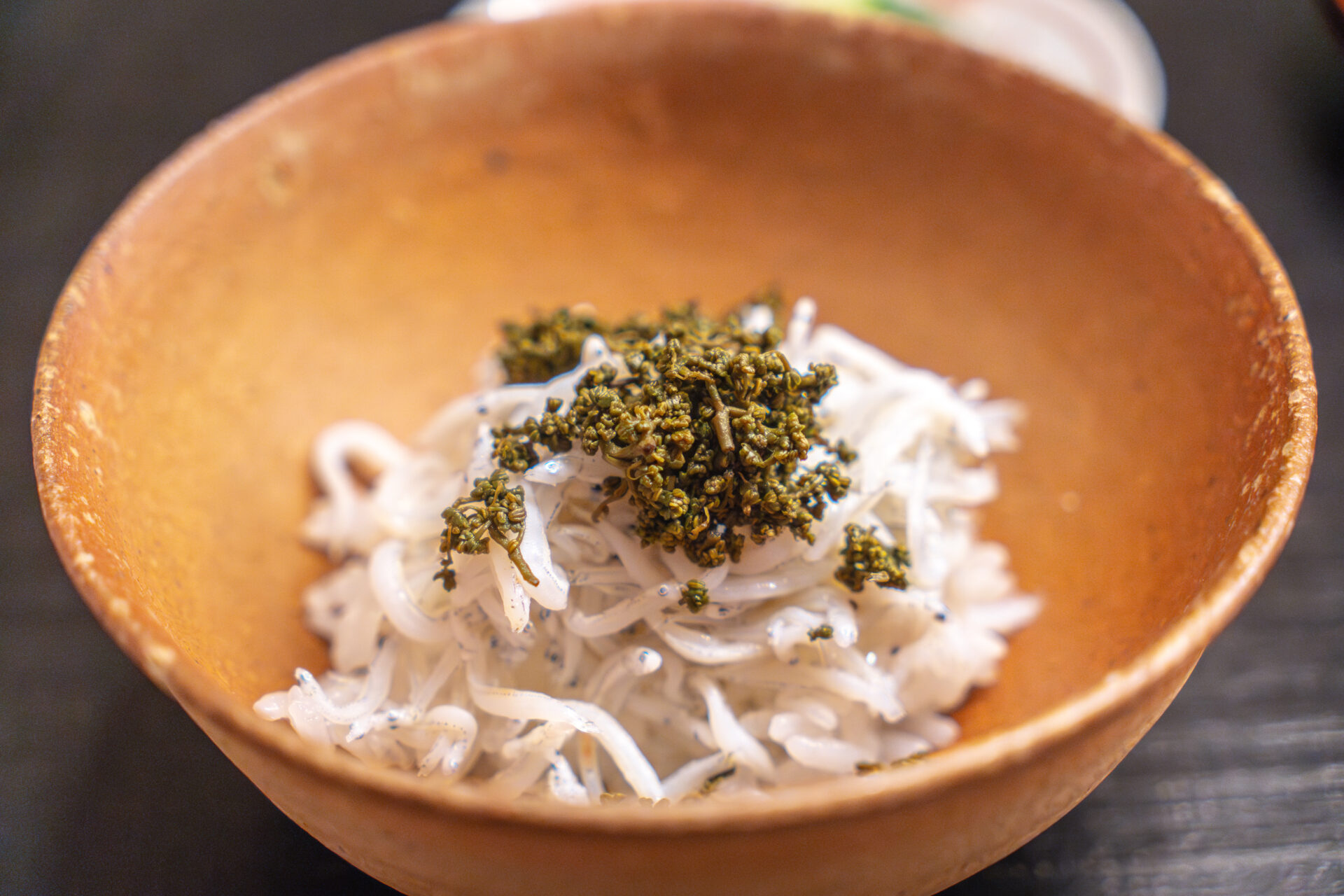
For the second bowl, a rich egg yolk sauce made with “Kyūkyoku Tamago” from Takemura Poultry Farm is poured on top. Silky and full-bodied, the yolk brings out the sweetness and depth of both rice and fish—so delicious it’s sure to bring a smile.
In fact, this same exceptional egg had quietly appeared earlier in the meal, used in the egg custard hidden within the soup course. Realizing this connection, one begins to sense how the ingredients are gently echoed throughout the meal, leaving a deeper emotional impression.
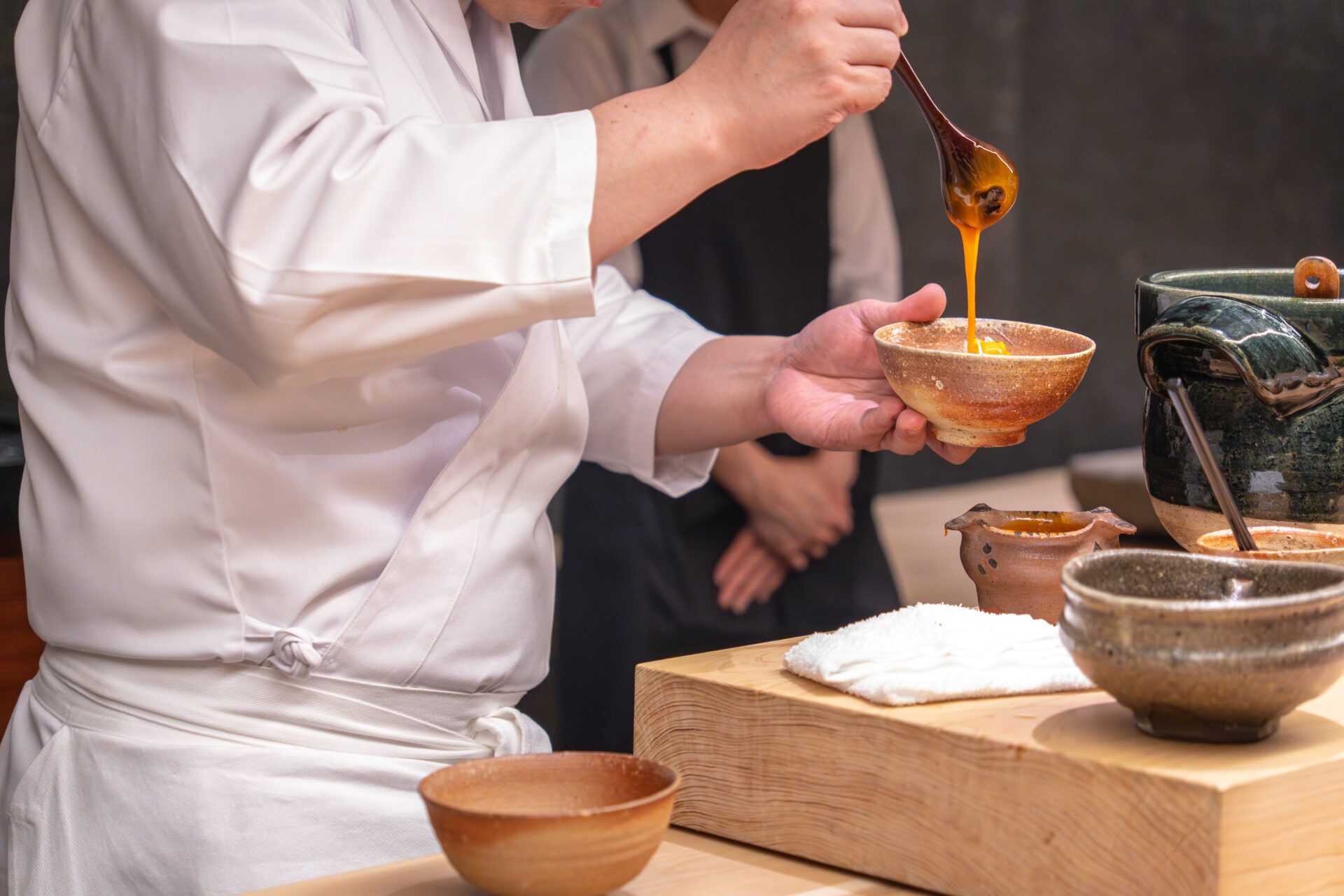
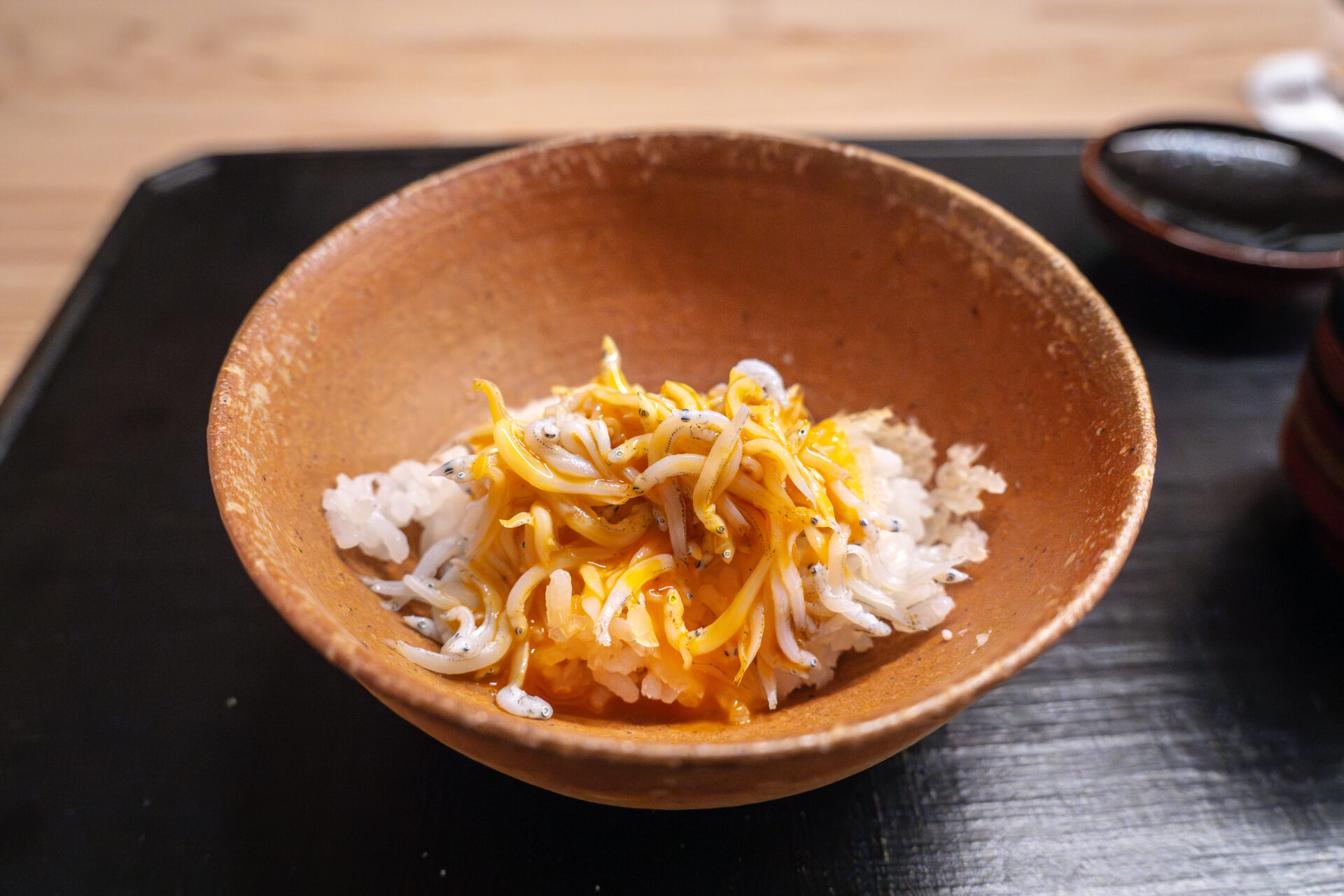
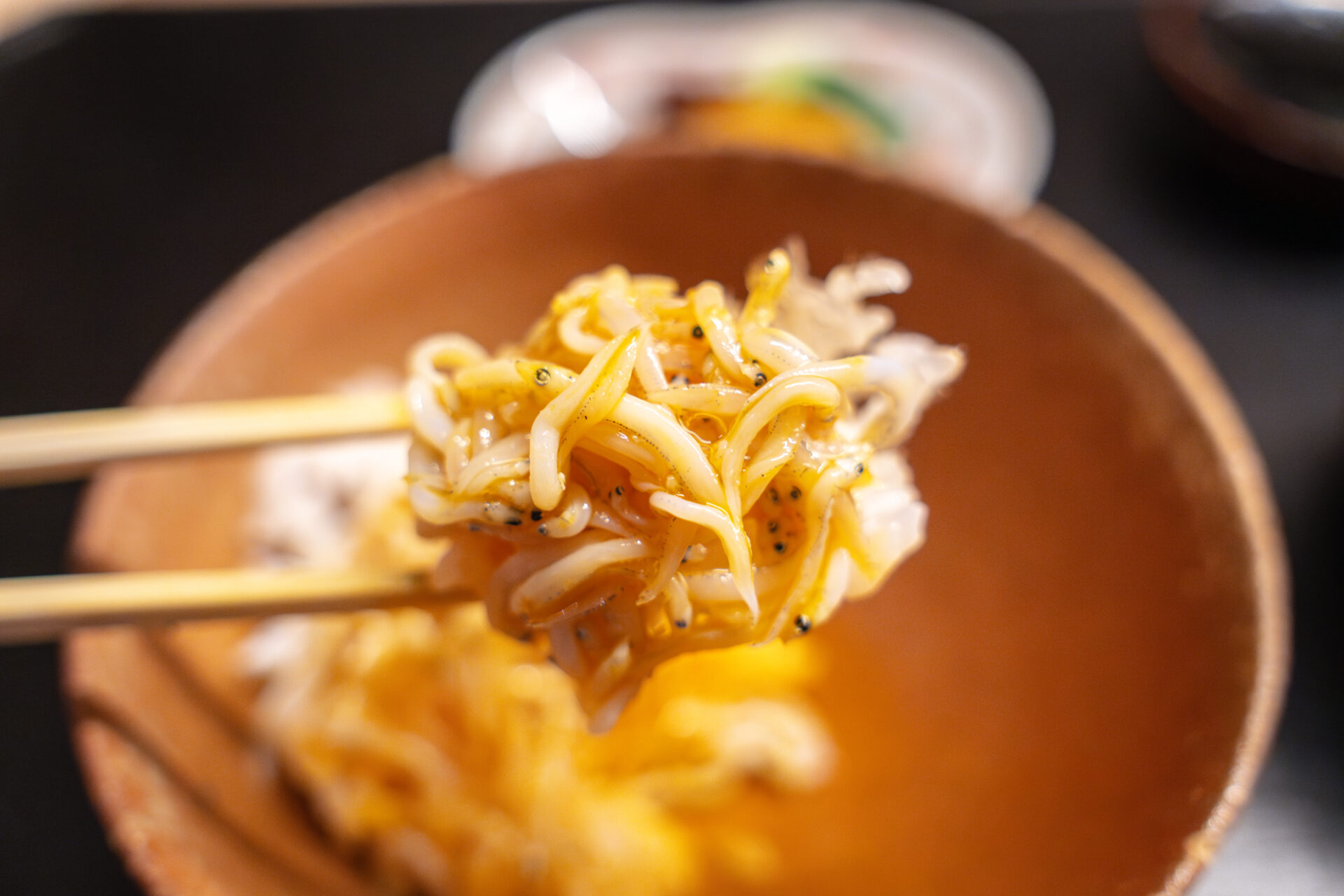
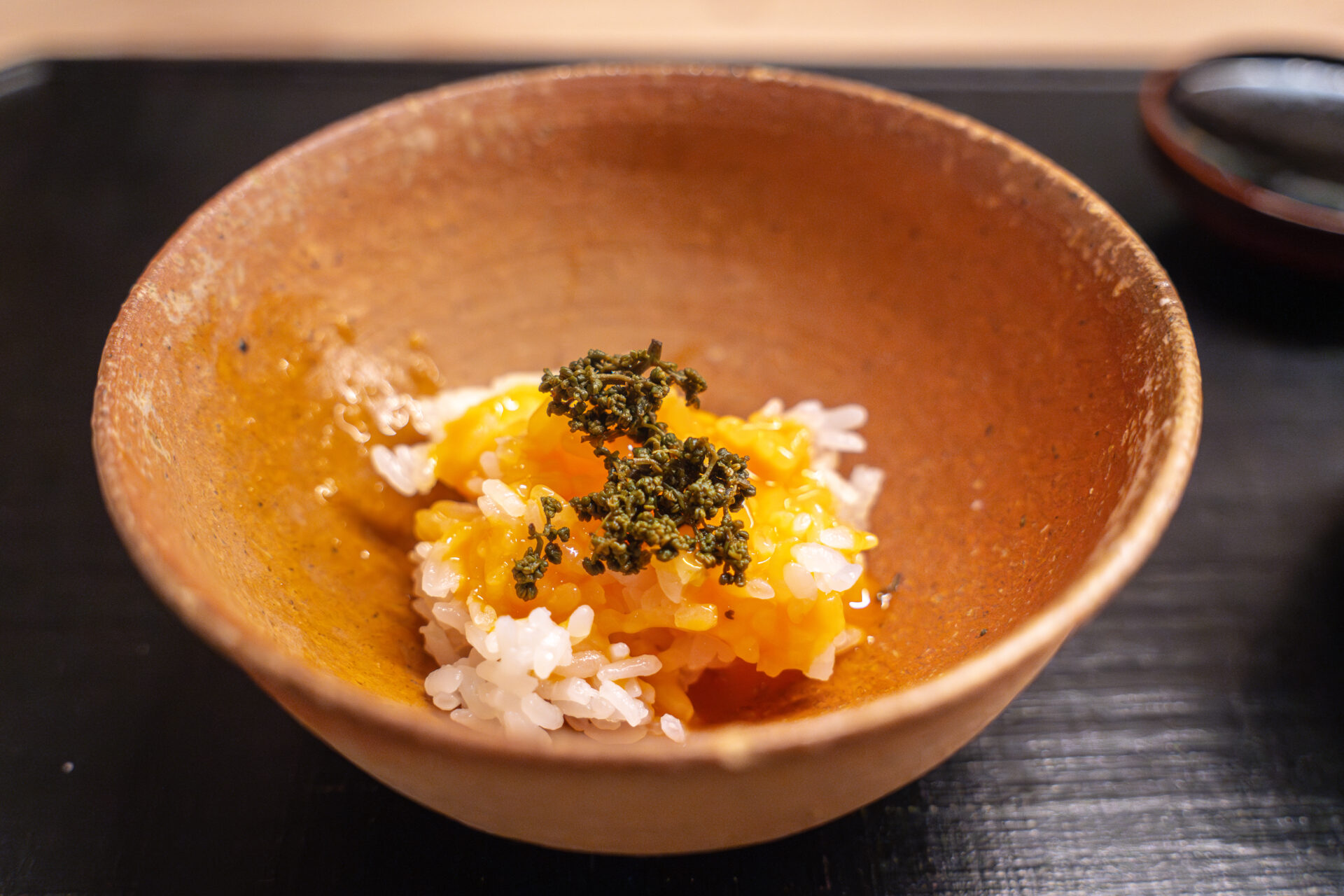
Dessert & Finale
Sweet Course ①: Quincy Melon with White Wine Jelly
The first dessert was a refreshing and visually elegant dish. Quincy melon from Kumamoto, scooped into neat spheres, was enveloped in a clear white wine jelly.
The jelly was subtly infused with cardamom and clove, adding a gentle aromatic depth without overpowering the natural sweetness of the melon.
Topped with a delicate red-and-white Pop Star (Dianthus) blossom, the dish captured the gentle transition of the seasons—a dessert as soothing to the eye as it was to the palate.
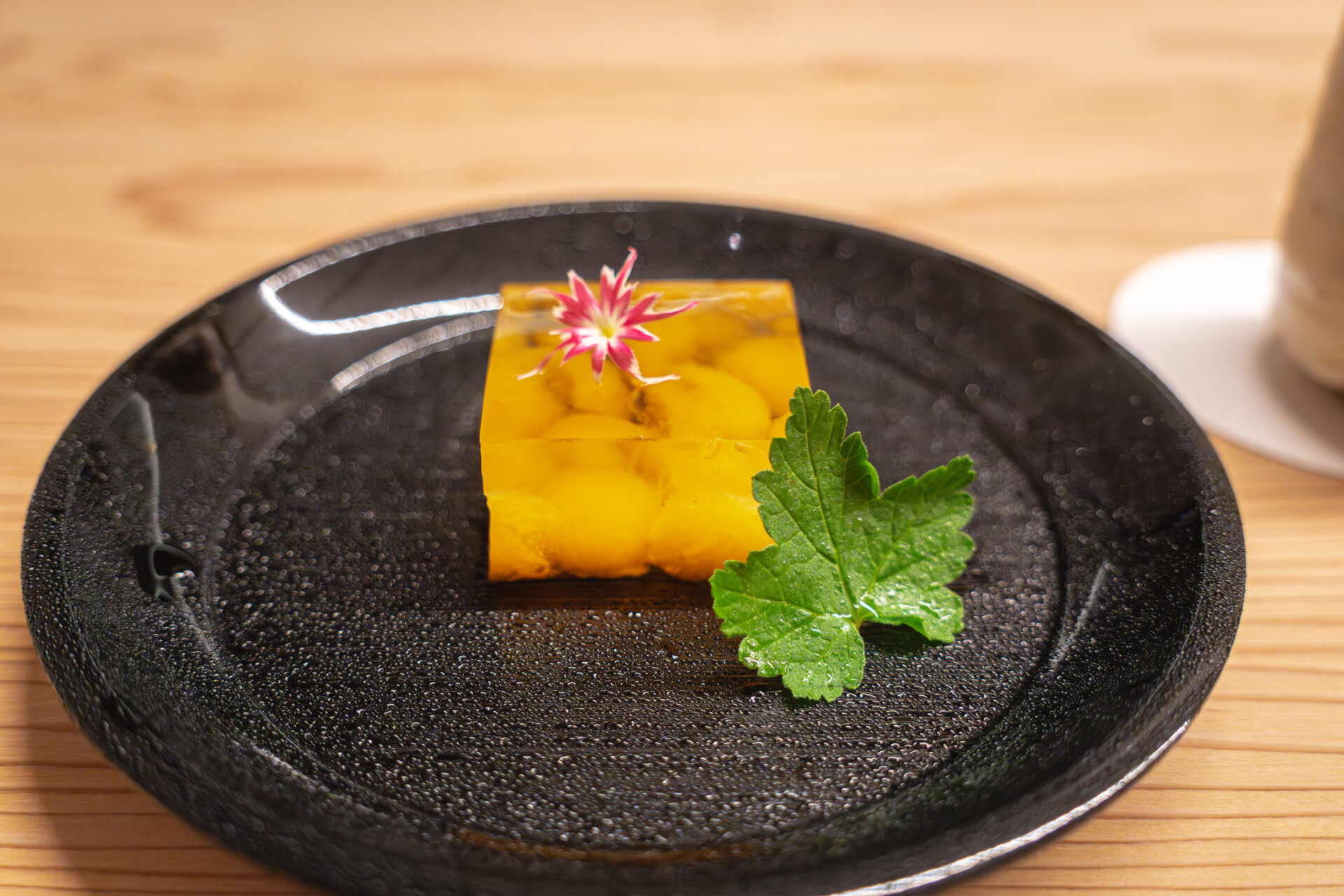
Sweet Course ②: Kurokawa Honke Kuzumochi with Rengetsubana Honey Cream
The second dessert featured freshly made kuzumochi from Kurokawa Honke in Yoshino—a specialty known for its elegant clarity and supple, delicate texture that melts effortlessly in the mouth.
Topped with a gentle dollop of whipped cream infused with renge (lotus blossom) honey from a beekeeping farm in Gojō, this was a rare treat. The honey, made from 100% lotus blossoms, is harvested only once every two years—its natural sweetness is mellow and pure, without cloying heaviness.
The soft fragrance of traditional Japanese ingredients met the creamy richness in perfect harmony, creating a final dessert that was both comforting and deeply soothing—an ending that relaxed not just the palate, but the heart.
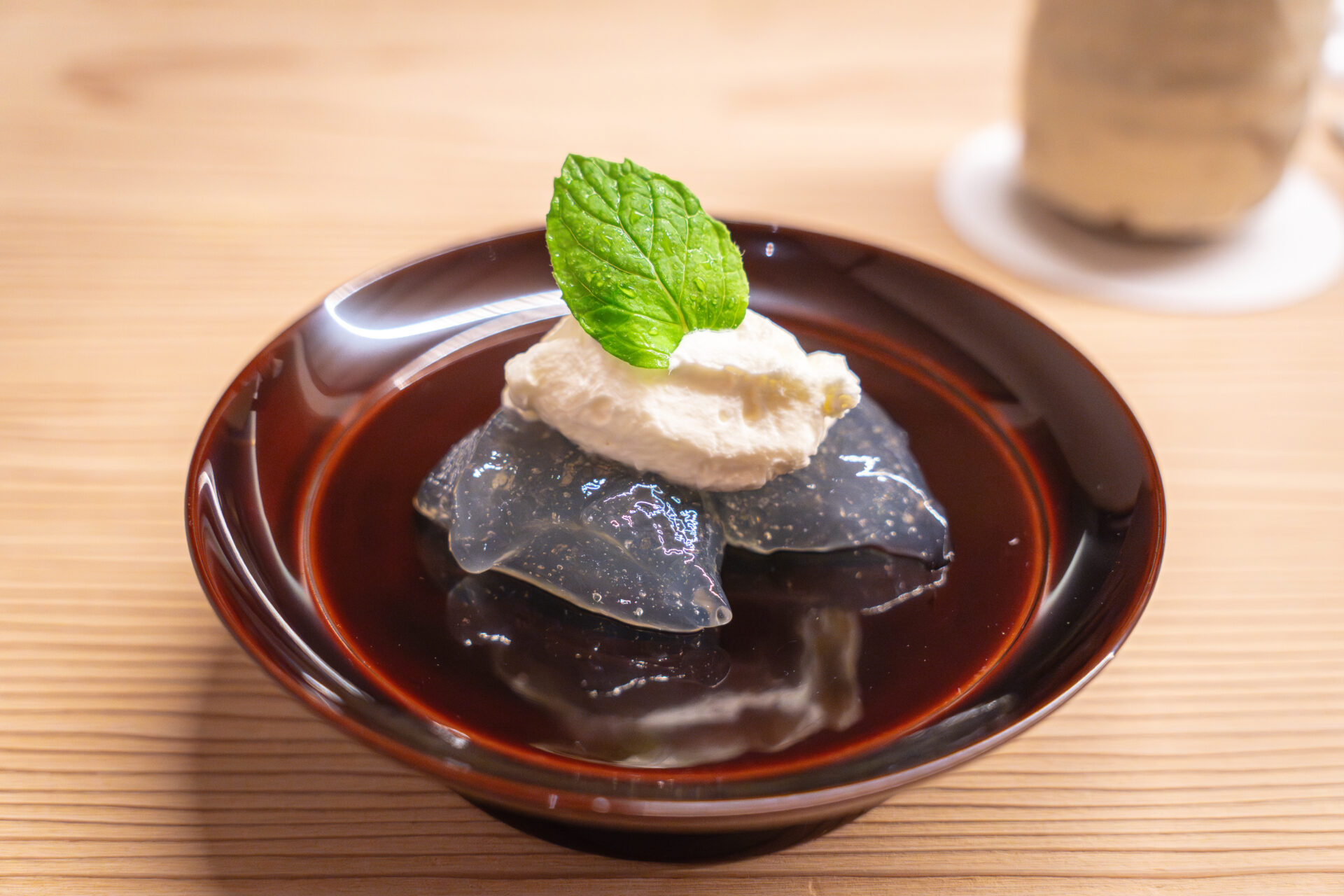
Summary & Impressions
Though the ingredient pairings often surprised, each dish settled gently and naturally into the body—never forced, always in harmony. Without leaning heavily on tradition or technical bravado, every plate seemed to quietly emerge from the chef’s own memory and intuition—his honest sense of “what I want to eat.”
At the heart of it all lies a deep affection for his hometown of Gojō, Nara. Local ingredients such as freshly harvested usui peas, hanazanshō, and Hinohikari rice were thoughtfully woven throughout the meal, grounding the experience in place and season.
Chef Hirooka’s culinary journey began at his family’s izakaya and continued through self-taught exploration of Japanese cuisine. Today, that path—formed not by rigid frameworks but by his own instincts—has earned him a Michelin star. That same individuality subtly colors the demeanor of his cooking.
Every aspect of the dining experience—each movement, each element of the space—reflected a refined and thoughtful aesthetic. It wasn’t just the food that nourished, but the passage of time itself that was allowed to be savored.
You feel the handwork behind each dish. You sense the sincerity of his taste. And you see a chef earnestly expressing his local roots through his own evolving voice. It’s the kind of place that makes you want to return in another season, to see what new “form of flavor” the chef will be moved to share.
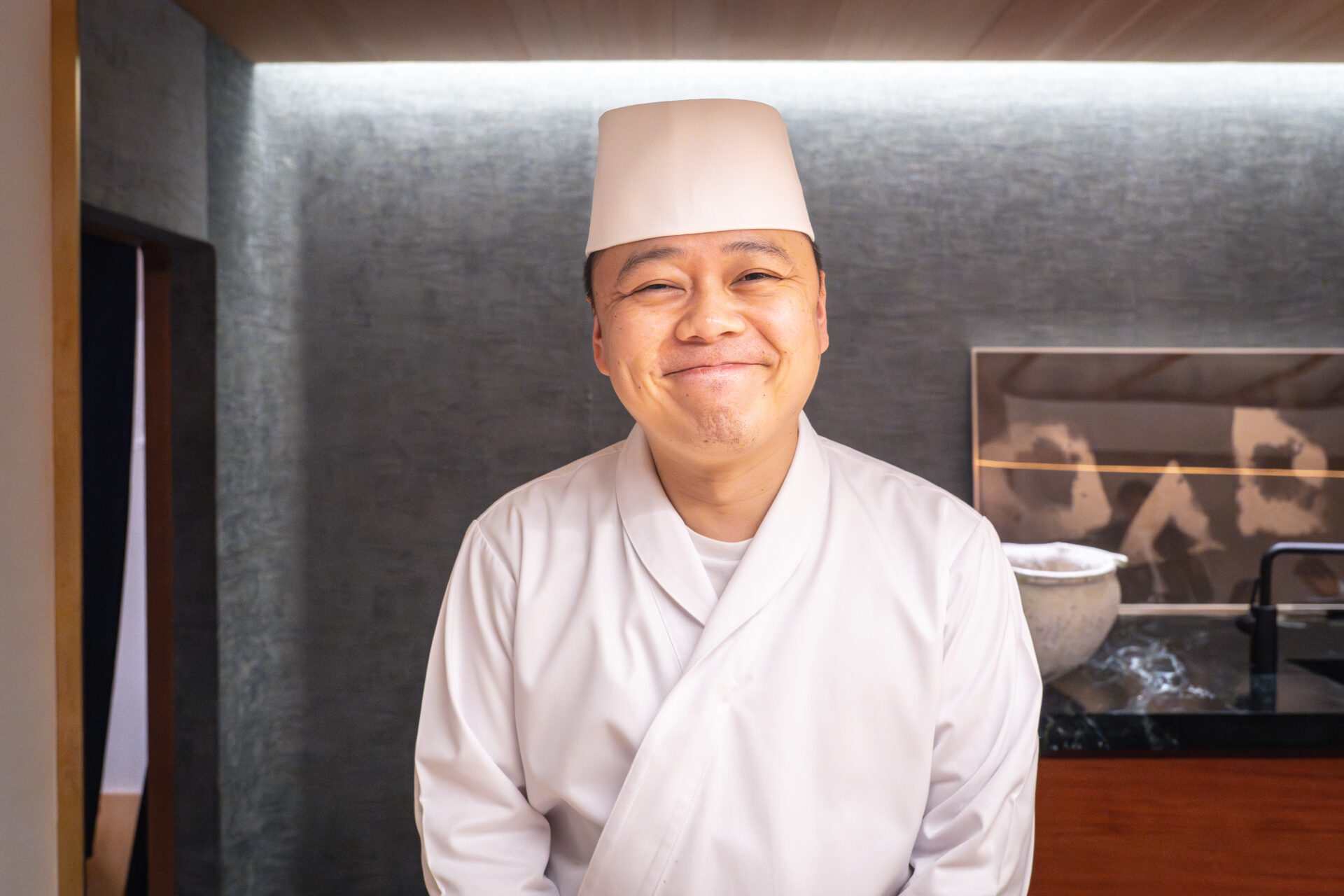
Reservations & Access Information
How to Reserve
-
By Phone: 0742‑95‑5587
-
Online: Via the TableCheck reservation form or through the link in the official Instagram profile
-
Advance Booking Required: Reservations must be made by the day before, for both lunch and dinner.
Access
Address: 15 Motohayashiin-chō, Nara City, Nara Prefecture
Nearest Stations:
-
Approx. 5-minute walk (400 m) from Kintetsu Nara Station
-
Approx. 14-minute walk (1.1 km) from JR Nara Station
Hours & Regular Closures
-
Lunch: 12:00 – 15:00 (Last Order)
-
Dinner: 18:30 – 21:00 (Last Order)
-
Closed: Every Wednesday, Thursday lunch, and lunch on the 1st of each month
※Please note that all seatings begin at the same time. If you anticipate being late, kindly contact the restaurant in advance.
- TAGS

